McGraw-Hill Education ACT 2017 (2016)
Part IV. THREE PRACTICE TESTS
ACT PRACTICE TEST 3
Answer Sheet
ENGLISH
1 ![]()
2 ![]()
3 ![]()
4 ![]()
5 ![]()
6 ![]()
7 ![]()
8 ![]()
9 ![]()
10 ![]()
11 ![]()
12 ![]()
13 ![]()
14 ![]()
15 ![]()
16 ![]()
17 ![]()
18 ![]()
19 ![]()
20 ![]()
21 ![]()
22 ![]()
23 ![]()
24 ![]()
25 ![]()
26 ![]()
27 ![]()
28 ![]()
29 ![]()
30 ![]()
31 ![]()
32 ![]()
33 ![]()
34 ![]()
35 ![]()
36 ![]()
37 ![]()
38 ![]()
39 ![]()
40 ![]()
41 ![]()
42 ![]()
43 ![]()
44 ![]()
45 ![]()
46 ![]()
47 ![]()
48 ![]()
49 ![]()
50 ![]()
51 ![]()
52 ![]()
53 ![]()
54 ![]()
55 ![]()
56 ![]()
57 ![]()
58 ![]()
59 ![]()
60 ![]()
61 ![]()
62 ![]()
63 ![]()
64 ![]()
65 ![]()
66 ![]()
67 ![]()
68 ![]()
69 ![]()
70 ![]()
71 ![]()
72 ![]()
73 ![]()
74 ![]()
75 ![]()
MATHEMATICS
1 ![]()
2 ![]()
3 ![]()
4 ![]()
5 ![]()
6 ![]()
7 ![]()
8 ![]()
9 ![]()
10 ![]()
11 ![]()
12 ![]()
13 ![]()
14 ![]()
15 ![]()
16 ![]()
17 ![]()
18 ![]()
19 ![]()
20 ![]()
21 ![]()
22 ![]()
23 ![]()
24 ![]()
25 ![]()
26 ![]()
27 ![]()
28 ![]()
29 ![]()
30 ![]()
31 ![]()
32 ![]()
33 ![]()
34 ![]()
35 ![]()
36 ![]()
37 ![]()
38 ![]()
39 ![]()
40 ![]()
41 ![]()
42 ![]()
43 ![]()
44 ![]()
45 ![]()
46 ![]()
47 ![]()
48 ![]()
49 ![]()
50 ![]()
51 ![]()
52 ![]()
53 ![]()
54 ![]()
55 ![]()
56 ![]()
57 ![]()
58 ![]()
59 ![]()
60 ![]()
READING
1 ![]()
2 ![]()
3 ![]()
4 ![]()
5 ![]()
6 ![]()
7 ![]()
8 ![]()
9 ![]()
10 ![]()
11 ![]()
12 ![]()
13 ![]()
14 ![]()
15 ![]()
16 ![]()
17 ![]()
18 ![]()
19 ![]()
20 ![]()
21 ![]()
22 ![]()
23 ![]()
24 ![]()
25 ![]()
26 ![]()
27 ![]()
28 ![]()
29 ![]()
30 ![]()
31 ![]()
32 ![]()
33 ![]()
34 ![]()
35 ![]()
36 ![]()
37 ![]()
38 ![]()
39 ![]()
40 ![]()
SCIENCE
1 ![]()
2 ![]()
3 ![]()
4 ![]()
5 ![]()
6 ![]()
7 ![]()
8 ![]()
9 ![]()
10 ![]()
11 ![]()
12 ![]()
13 ![]()
14 ![]()
15 ![]()
16 ![]()
17 ![]()
18 ![]()
19 ![]()
20 ![]()
21 ![]()
22 ![]()
23 ![]()
24 ![]()
25 ![]()
26 ![]()
27 ![]()
28 ![]()
29 ![]()
30 ![]()
31 ![]()
32 ![]()
33 ![]()
34 ![]()
35 ![]()
36 ![]()
37 ![]()
38 ![]()
39 ![]()
40 ![]()
You may wish to remove these sample answer document pages to respond to the practice ACT Writing Test.
![]()
ENGLISH TEST
45 Minutes – 75 Questions
DIRECTIONS: In the passages that follow, some words and phrases are underlined and numbered. In the answer column, you will find alternatives for the words and phrases that are underlined. Choose the alternative that you think is best and fill in the corresponding bubble on your answer sheet. If you think that the original version is best, choose “NO CHANGE,” which will always be either answer choice A or F. You will also find questions about a particular section of the passage, or about the entire passage. These questions will be identified by either an underlined portion or by a number in a box. Look for the answer that clearly expresses the idea, is consistent with the style and tone of the passage, and makes the correct use of standard written English. Read the passage through once before answering the questions. For some questions, you should read beyond the indicated portion before you answer.
PASSAGE I
Born to Hunt
I watch his black, leathery nose as it sporadically quivers, sensing new smells in the air, ![]() His head remains
His head remains ![]() perfectly still. His white tail curls into the letter “C.” He
perfectly still. His white tail curls into the letter “C.” He ![]() to be perfectly balanced, a beautiful specimen, poised at the start of the two-track road.
to be perfectly balanced, a beautiful specimen, poised at the start of the two-track road. ![]() this adorable canine was a mere twelve weeks old, my young son already knew the right name was “Hunter.”
this adorable canine was a mere twelve weeks old, my young son already knew the right name was “Hunter.”
1. A. NO CHANGE
B. trying desperately in identifying them.
C. desperate in an attempt to identify them.
D. trying, desperate, to identify them.
2. F. NO CHANGE
G. perfectly erect his body
H. perfectly, erect his body
J. perfectly erect his body,
3. A. NO CHANGE
B. appeared
C. appears
D. has appeared
4. F. NO CHANGE
G. When
H. So
J. For
We had visited the local animal shelter three times in the previous six months, searching for the perfect boy/dog chemistry. Disappointed after trial playtimes with several older animals, we suddenly realized we had yet to visit the nursery, ![]() There he
There he ![]() a short-haired, pink-skinned, white and black spotted angel of a puppy. The bond was instant.
a short-haired, pink-skinned, white and black spotted angel of a puppy. The bond was instant.
5. Which choice provides the most specific and precise information?
A. NO CHANGE
B. which housed other dogs.
C. where we saw puppies.
D. where we hoped to find a puppy.
6. F. NO CHANGE
G. were
H. is
J. are
Hunter ![]() is what he aspires to be. His black, velvet ears
is what he aspires to be. His black, velvet ears ![]() and held firmly back as he attempts to capture even the slightest of sounds. I know as I watch him that at any moment he may choose to ignore the meager training
and held firmly back as he attempts to capture even the slightest of sounds. I know as I watch him that at any moment he may choose to ignore the meager training ![]() him and bound off mindlessly
him and bound off mindlessly ![]() 100 acres of which he considers his personal territory. I could lose him; I know this. Even the neon orange, bell-adorned collar around his neck is no assurance.
100 acres of which he considers his personal territory. I could lose him; I know this. Even the neon orange, bell-adorned collar around his neck is no assurance.
7. A. NO CHANGE
B. is his name; and a hunter
C. is his name, and a hunter
D. is his name. And a hunter
8. F. NO CHANGE
G. have risen
H. are raised
J. were raised
9. A. NO CHANGE
B. I did give
C. I once by giving
D. I gave
10. Which of the following would NOT be an acceptable alternative to the underlined portion?
F. toward the woods
G. to the woods
H. over toward the direction of the woods
J. in the direction of the woods
As I stand there watching, ![]() at the instincts coursing through his entire being,
at the instincts coursing through his entire being, ![]() “Should I pursue the dark but enticing unknowns of the forest before me, or stay back with the comfort and warmth of those who care for me?” He turns his head toward me as I beckon to him, then
“Should I pursue the dark but enticing unknowns of the forest before me, or stay back with the comfort and warmth of those who care for me?” He turns his head toward me as I beckon to him, then ![]() to the yard, grabbing his rubber ball disc in his mouth, bounding into the air as he runs,
to the yard, grabbing his rubber ball disc in his mouth, bounding into the air as he runs, ![]()
11. A. NO CHANGE
B. marveling
C. and marvels
D. I marveled
12. The underlined portion would best be placed:
F. where it is now.
G. after the word watching.
H. after the word there.
J. after the word as.
13. Which choice best describes the way the dog returns to the writer of the story?
A. NO CHANGE
B. lopes back
C. returns at a slow trot
D. sadly comes home
14. If the last part of this sentence was deleted (ending the sentence with a period), the paragraph would lose:
F. the disappointment of the dog’s owner.
G. an understanding of the dog’s hunting instincts.
H. a description of the dog’s attitude.
J. the depth of dog ownership.
Question 15 asks about the preceding passage as a whole.
15. Suppose the writer’s goal for this passage was to convince the reader to train dogs to hunt. Would this essay fulfill the writer’s goal?
A. Yes, because the writer is very accepting of the dog’s natural instincts to hunt.
B. Yes, because the writer knows that, with better training, the dog would be a good hunting dog.
C. No, because the passage specifically encourages readers not to train dogs to hunt.
D. No, because the passage restricts its focus to a discussion of a family pet.
PASSAGE II
Don’t Fence Me In
One of the first quandaries a new homeowner faces is ![]() a fence. Most people are naturally territorial, at least to some extent, and are inclined to mark off their boundaries as a statement to
a fence. Most people are naturally territorial, at least to some extent, and are inclined to mark off their boundaries as a statement to ![]() “Here’s my line; don’t cross it.” However, civilized society
“Here’s my line; don’t cross it.” However, civilized society ![]() that this fencing be done in a genial manner. Excuses are offered to the neighbor: “We need to keep our dog confined,” or “This fence is only necessary for our children.” In reality, fences are most often erected not to keep loved ones in, but to keep outsiders out.
that this fencing be done in a genial manner. Excuses are offered to the neighbor: “We need to keep our dog confined,” or “This fence is only necessary for our children.” In reality, fences are most often erected not to keep loved ones in, but to keep outsiders out.
16. F. NO CHANGE
G. the, issue of
H. the issue of
J. the, issue of,
17. Which of the following alternatives to the underlined portion would NOT be acceptable?
A. their neighbors:
B. their neighbors,
C. their neighbors. It’s a way to say
D. their neighbors, as if to say
18. F. NO CHANGE
G. dictates
H. dictated
J. will be dictating
People also ![]() their own privacy, and a solid wood fence or concrete wall will certainly accomplish that goal. Sometimes, however, when someone is on the second or third level of his home,
their own privacy, and a solid wood fence or concrete wall will certainly accomplish that goal. Sometimes, however, when someone is on the second or third level of his home, ![]() all the goings-on in his neighbor’s private backyard are clearly visible.
all the goings-on in his neighbor’s private backyard are clearly visible. ![]() constructing a solid screen such as a fence or wall, some people prefer to take a more subtle route and plant
constructing a solid screen such as a fence or wall, some people prefer to take a more subtle route and plant ![]() This option works well as long as the natural barrier is easy to maintain year-round. Keep in mind, though, that most plants require some time to grow. Climbing ivies or deciduous trees—
This option works well as long as the natural barrier is easy to maintain year-round. Keep in mind, though, that most plants require some time to grow. Climbing ivies or deciduous trees—![]() —prove to be ineffective protection
—prove to be ineffective protection ![]() prying eyes and perked ears. Evergreen trees and shrubs are the best choices for fences
prying eyes and perked ears. Evergreen trees and shrubs are the best choices for fences ![]() because they keep their leaves and needles throughout the year. One must take care, however, to select species that are suited to their intended purpose and environment. Planting tall, thin Cryptomeria trees
because they keep their leaves and needles throughout the year. One must take care, however, to select species that are suited to their intended purpose and environment. Planting tall, thin Cryptomeria trees ![]() is not a good idea. Plant two or three rows of the trees rather than a single row of trees along a property line.
is not a good idea. Plant two or three rows of the trees rather than a single row of trees along a property line.
19. A. NO CHANGE
B. reject
C. value
D. undermine
20. F. NO CHANGE
G. by this time
H. for this reason
J. DELETE the underlined portion.
21. A. NO CHANGE
B. Rather, than
C. Rather than
D. Rather, then,
22. F. NO CHANGE
G. trees, shrubs vines, and the like
H. trees shrubs vines, and the like
J. trees, shrubs, vines, and the like
23. A. NO CHANGE
B. in that they lose they’re foliage
C. by losing they’re foliage
D. lose their foliage
24. F. NO CHANGE
G. for
H. toward
J. against
25. A. NO CHANGE
B. in place of deciduous trees
C. as opposed to deciduous trees
D. DELETE the underlined portion.
26. F. NO CHANGE
G. too far apart for, example
H. too far apart, for example,
J. too far apart for example,
When considering how to mark a property line and create ![]() it is important to
it is important to ![]() carefully plan the type of fence you want to construct, and consider the statement you want to make to your
carefully plan the type of fence you want to construct, and consider the statement you want to make to your ![]() Privacy fences can take time to come to full maturity, and more permanent fencing can be
Privacy fences can take time to come to full maturity, and more permanent fencing can be ![]()
27. Which of the following creates the most appropriate image, based on the context of the passage?
A. NO CHANGE
B. fun and enjoyment
C. relaxation and vacation time
D. safety and recreation
28. F. NO CHANGE
G. cautiously and
H. take care to
J. DELETE the underlined portion
29. A. NO CHANGE
B. neighbors
C. neighbor’s
D. neighbors’s
30. F. NO CHANGE
G. full of cost
H. a lot of money
J. expensive to build
PASSAGE III
Maya Angelou
Incredible inner ![]() gift with words, and a golden heart are terms
gift with words, and a golden heart are terms ![]() apply describe Maya Angelou. Born in 1928 in St. Louis, Missouri, Maya Angelou experienced a difficult and transient childhood. Much of
apply describe Maya Angelou. Born in 1928 in St. Louis, Missouri, Maya Angelou experienced a difficult and transient childhood. Much of ![]() is reflected in her first book, I Know Why the Caged Bird Sings. As suggested by its title, this autobiography describes the tumultuous and often frightening aspects of Angelou’s
is reflected in her first book, I Know Why the Caged Bird Sings. As suggested by its title, this autobiography describes the tumultuous and often frightening aspects of Angelou’s ![]() both sympathize with and marvel at her ability to cope with, even rise above, many adverse circumstances. Following one
both sympathize with and marvel at her ability to cope with, even rise above, many adverse circumstances. Following one ![]() incident, Maya spent the next five years in utter silence, which caused her mother to send Maya to live in Stamps, Arkansas, with Maya’s grandmother.
incident, Maya spent the next five years in utter silence, which caused her mother to send Maya to live in Stamps, Arkansas, with Maya’s grandmother.
31. A. NO CHANGE
B. beauty; an ingenious
C. beauty, an ingenious
D. beauty with an ingenious,
32. F. NO CHANGE
G. who
H. one
J. they
33. A. NO CHANGE
B. her young life
C. that which is her young life
D. that her young life
34. Which of the following alternatives to the underlined portion would NOT be acceptable?
F. teen years, which causes the reader to
G. teen years. This causes the reader to
H. teen years; the reader can
J. teen years. Causing the reader to
35. If the writer of this essay deleted the underlined portion, the essay would primarily lose:
A. an explanation for Angelou’s subsequent behavior.
B. the essence of the entire passage.
C. an argument for the writer’s point of view.
D. an unnecessary detail about Angelou’s life.
As a young woman in Arkansas, Angelou performed a variety of different jobs, including dancing, singing, and acting. ![]() Angelou went on to become active in the
Angelou went on to become active in the ![]() pursued her dream of becoming a writer as well. During her lifetime, she wrote many volumes of poetry and over a dozen books. Since 1981, Angelou has resided at Wake Forest University where she is the first Reynolds Professor of American Studies, a prestigious position.
pursued her dream of becoming a writer as well. During her lifetime, she wrote many volumes of poetry and over a dozen books. Since 1981, Angelou has resided at Wake Forest University where she is the first Reynolds Professor of American Studies, a prestigious position. ![]() She is one of only two people ever to have read her own poetry at the inauguration of a United States
She is one of only two people ever to have read her own poetry at the inauguration of a United States ![]()
36. Which of the following words from the preceding sentence could be deleted without negatively impacting the grammar and clarity of the sentence?
F. variety
G. different
H. singing
J. including
37. A. NO CHANGE
B. civil rights movement and
C. civil rights, movement, and
D. civil, rights, movement and
38. At this point, the writer is considering adding the following true statement:
The Reynolds Professorship pays well.
Should the writer make this addition here?
F. Yes, because it indicates that Angelou will keep this position for the rest of her life.
G. Yes, because it shows how important the Reynolds professorship appointment is for Angelou’s career.
H. No, because it detracts from the points regarding Angelou’s difficult childhood.
J. No, because it does not substantially add to the essence of the essay.
39. A. NO CHANGE
B. president, Bill Clinton.
C. president.
D. president; Bill Clinton.
![]() an interview with Maya Angelou is truly a treat. With her deep, throaty voice and her ability to make words sound like either
an interview with Maya Angelou is truly a treat. With her deep, throaty voice and her ability to make words sound like either ![]() or deafening cannons, Maya Angelou
or deafening cannons, Maya Angelou ![]() in even the most hardened listener. Angelou has the ability
in even the most hardened listener. Angelou has the ability ![]() emotion in such a way that
emotion in such a way that ![]() become heavy with gratitude for life and hope for humanity.
become heavy with gratitude for life and hope for humanity.
40. F. NO CHANGE
G. Listening to or watching
H. Listening to or watching with
J. Listening, or watching
41. A. NO CHANGE
B. blossoming flowers
C. blossoms of flowers
D. blossoms and flowers
42. F. NO CHANGE
G. a sense of wonder and joy can instill
H. a sense she can instill of wonder and joy
J. can instill a sense of wonder and joy
43. A. NO CHANGE
B. for eliciting
C. to elicit
D. with eliciting
44. F. NO CHANGE
G. a listener has
H. all who listen will have
J. DELETE the underlined portion.
Question 45 asks about the preceding passage as a whole.
45. Suppose the writer had intended to write an essay focusing on Southern poverty. Would this essay successfully fulfill the writer’s goal?
A. Yes, because the writer clearly states that Angelou grew up in Arkansas under difficult circumstances.
B. Yes, because the essay discusses Angelou’s first book about poverty, I Know Why the Caged Bird Sings.
C. No, because the writer’s goal is to describe how people can rise above bad situations.
D. No, because the essay’s main focus is on the life and accomplishments of Maya Angelou.
PASSAGE IV
Summer Visits
[1] Visiting my grandparents every summer was a definite highlight of ![]() [2] Grandma and I would take the city bus just to go up the road
[2] Grandma and I would take the city bus just to go up the road ![]() nearest shopping center. [3] That one mile
nearest shopping center. [3] That one mile ![]() a happy eternity to me. [4] There, at the “five-and-dime,” Grandma would purchase yards and yards of fabric to take home to my mother. [5] Grandma would let me help choose the material, knowing that much of it would become my new fall school clothes.
a happy eternity to me. [4] There, at the “five-and-dime,” Grandma would purchase yards and yards of fabric to take home to my mother. [5] Grandma would let me help choose the material, knowing that much of it would become my new fall school clothes. ![]()
46. F. NO CHANGE
G. the time when I was young.
H. the summer visits.
J. my young childhood.
47. A. NO CHANGE
B. one mile to the
C. one mile; to the
D. one mile: to the
48. F. NO CHANGE
G. seemed
H. seeming like
J. seems as
49. The writer is considering adding the following sentence to further describe her mother’s talent for sewing:
By this time, she had become an excellent seamstress under my grandmother’s tutelage.
The new sentence would best amplify and be placed after Sentence:
A. 2
B. 3
C. 4
D. 5
![]() I spent more time with Grandma Ritz, I must admit the brief moments with Grandpa Ritz
I spent more time with Grandma Ritz, I must admit the brief moments with Grandpa Ritz ![]() Grandpa always seemed to be in and out, but mostly out.
Grandpa always seemed to be in and out, but mostly out. ![]() I do remember his over-sized, green chair with its large matching ottoman. The chair and ottoman
I do remember his over-sized, green chair with its large matching ottoman. The chair and ottoman ![]() to all of the grandchildren,
to all of the grandchildren, ![]() Grandpa was off on one of his many excursions. Right next to Grandpa’s chair was his cherished bookstand, complete with reading lamp and reading glasses. I can still picture Grandpa sitting in that chair in front of his radio (and later a black-and-white television set), happily reading his favorite Hemingway novel.
Grandpa was off on one of his many excursions. Right next to Grandpa’s chair was his cherished bookstand, complete with reading lamp and reading glasses. I can still picture Grandpa sitting in that chair in front of his radio (and later a black-and-white television set), happily reading his favorite Hemingway novel. ![]() indeed, he only stood about five and a half feet tall. Still, Grandpa was a
indeed, he only stood about five and a half feet tall. Still, Grandpa was a ![]() in that chair.
in that chair.
50. F. NO CHANGE
G. Except
H. Because
J. As for
51. Which of the following choices would NOT be an acceptable alternative for the underlined portion?
A. are most memorable
B. truly are my most memorable
C. are the ones I remember most
D. being my most memorable
52. If the writer deleted the phrase but mostly out from the preceding sentence, the sentence would primarily lose:
F. the implication that the writer’s grandfather was gone much of the time.
G. details about the writer’s relationship with her grandmother.
H. a sense of the grandparents’ relationship with each other.
J. an explanation of where the grandfather spent most of his time.
53. A. NO CHANGE
B. were forbidden
C. are being forbidden
D. will be forbidden
54. F. NO CHANGE
G. despite the fact that
H. including any time when
J. instead of when
55. A. NO CHANGE
B. Grandpa, even when I was a child, to me seemed like a small man
C. Grandpa seemed like a small man to me, even when I was a child
D. Grandpa seemed to me, even as a child, like a small man
56. F. NO CHANGE
G. royalty
H. king
J. king of royalty
My fondest memories are of Grandpa and his fishing lures. An avid fly-fisherman, Grandpa probably fished every river within driving distance of his home and made his own lures. When he wasn’t out in his waders somewhere, he could often be found bent over his garage workbench ![]() putting together bobbers, colorful feathers, and shiny metal fish bodies. Occasionally, Grandpa would invite me to accompany him to the garage,
putting together bobbers, colorful feathers, and shiny metal fish bodies. Occasionally, Grandpa would invite me to accompany him to the garage, ![]() me how to tie all of the parts together with a piece of thin fishing wire. He always assured me that my humble creation would be an asset on his next fishing expedition. Maybe it would even nab the big one!
me how to tie all of the parts together with a piece of thin fishing wire. He always assured me that my humble creation would be an asset on his next fishing expedition. Maybe it would even nab the big one!
57. The best placement for the underlined portion would be:
A. where it is now.
B. after the word waders.
C. after the word somewhere.
D. after the word feathers.
58. F. NO CHANGE
G. he shows
H. so he would show
J. as if he could show
When I became a teenager, my solo summer visits with my grandparents ended. By then, ![]() moved out of the city and into the country, where they purchased acres and acres of hilly woods. While I never grew to love their new home as I did the old one, this property became my Grandpa’s sanctuary. He spent nearly every day cleaning out the deadwood, carving walking paths along the creek, and building wooden birdhouses.
moved out of the city and into the country, where they purchased acres and acres of hilly woods. While I never grew to love their new home as I did the old one, this property became my Grandpa’s sanctuary. He spent nearly every day cleaning out the deadwood, carving walking paths along the creek, and building wooden birdhouses.
59. A. NO CHANGE
B. they
C. my grandparents had
D. it had
Question 60 asks about the preceding passage as a whole.
60. Suppose the writer had intended to write an essay describing the relationship between her grandparents. Would this essay accomplish the writer’s goal?
F. Yes, because the writer clearly describes how important her grandparents were during her childhood.
G. Yes, because the writer recalls fond memories of both her grandparents.
H. No, because the essay does not mention the writer’s grandparents’ relationship with one another.
J. No, because the writer clearly spent more time with her grandmother than with her grandfather.
PASSAGE V
The Electric Motor Team
In 1834, Thomas Davenport, a poor blacksmith with no formal education, and his wife Emily ![]() to make one of the most
to make one of the most ![]() inventions in the history of the world—the electric motor. Thomas was working in Vermont when he heard of an innovative technique used to
inventions in the history of the world—the electric motor. Thomas was working in Vermont when he heard of an innovative technique used to ![]() with an electromagnet. He was so intrigued, that he convinced his brother to raise money, and the two of them
with an electromagnet. He was so intrigued, that he convinced his brother to raise money, and the two of them ![]() an electromagnet.
an electromagnet.
61. A. NO CHANGE
B. jointly worked with each other
C. worked with each other together on a project
D. worked together
62. Which of the choices would be most appropriate here?
F. NO CHANGE
G. justified
H. important
J. authoritative
63. A. NO CHANGE
B. more efficiently separating iron ore
C. separates iron ore more efficiently
D. separate iron ore more efficiently
64. F. NO CHANGE
G. purchase
H. purchasing
J. to purchase
Thomas brought it home and began to experiment with it, first by disassembling it. His wife Emily took a keen interest in the project. Thomas’ ![]() “had a fine education and was as enthusiastic as he was, … [She] wrote down exactly the way the wire was wound on, and all about it, from beginning to end.” Thomas began work on his own electromagnet by constructing a core
“had a fine education and was as enthusiastic as he was, … [She] wrote down exactly the way the wire was wound on, and all about it, from beginning to end.” Thomas began work on his own electromagnet by constructing a core ![]() but he realized he needed an insulator for the wires. Emily sacrificed her
but he realized he needed an insulator for the wires. Emily sacrificed her ![]() Thomas and Emily then used
Thomas and Emily then used ![]() to insulate the wires.
to insulate the wires.
65. A. NO CHANGE
B. brother, who witnessed much of their work, said that Emily;
C. brother who witnessed much of their work, said that Emily
D. brother, who witnessed much of their work said that Emily
66. Given that all the choices are true, which one most specifically and vividly describes the electromagnetic core?
F. NO CHANGE
G. made of tightly wound iron wires
H. with some wire
J. like the one he had seen previously
67. A. NO CHANGE
B. silk wedding dress; and tore it into strips.
C. silk wedding dress and tore it, into strips.
D. silk wedding dress and tore it into strips.
68. F. NO CHANGE
G. these strips
H. torn strips of wedding silk from her dress
J. Emily’s strips of silk wedding dress fabric
[1] Thomas was convinced that the improved electromagnet they built could be ![]() spin a wheel with attached magnets. [2] Thomas grew very frustrated, until Emily suggested that mercury might be used as a conductor. [3] For several months, Thomas could not get it to work. [4]
spin a wheel with attached magnets. [2] Thomas grew very frustrated, until Emily suggested that mercury might be used as a conductor. [3] For several months, Thomas could not get it to work. [4] ![]() as the underlying magnets attracted those on the wheel, but as soon as the underlying magnets were opposite the magnets on the wheel, the wheel would stop. [5] There was no way to quickly reverse the current in the electromagnet before the wheel stopped. [6]
as the underlying magnets attracted those on the wheel, but as soon as the underlying magnets were opposite the magnets on the wheel, the wheel would stop. [5] There was no way to quickly reverse the current in the electromagnet before the wheel stopped. [6] ![]() it, and the wheel turned continuously as expected.
it, and the wheel turned continuously as expected.![]()
![]() After building several more sophisticated models, he finally received the patent for the first electric motor in 1837. Although there was great initial excitement in
After building several more sophisticated models, he finally received the patent for the first electric motor in 1837. Although there was great initial excitement in ![]() did not gain widespread popularity until after Thomas Davenport’s death. However, within forty years of his death, electric motors were being commonly used in trains and trolleys, and
did not gain widespread popularity until after Thomas Davenport’s death. However, within forty years of his death, electric motors were being commonly used in trains and trolleys, and ![]()
69. A. NO CHANGE
B. utilized for the
C. used to
D. designed with
70. F. NO CHANGE
G. The wheel by starting
H. The wheel commenced to start
J. The wheel, would, start
71. A. NO CHANGE
B. would of tried
C. try
D. tried
72. For the sake of the unity and coherence of this paragraph, Sentence 2 should be placed:
F. where it is now.
G. after Sentence 4.
H. after Sentence 5.
J. after Sentence 6.
73. Which of the following sentences offers the best introduction to this paragraph?
A. Emily Davenport’s contribution to the electric motor was invaluable.
B. Building a working electric motor was very difficult and expensive.
C. Thomas’ first application for a patent was rejected at a time when there were no other electrical patents at all.
D. The U.S. Patent Office was first proposed by Thomas Jefferson.
74. F. NO CHANGE
G. the scientific community and the media, the electric motor
H. the scientific community and the media and the electric motor
J. the scientific community, the media, and the electric motor
75. What function does the underlined portion serve in the essay?
A. The author is showing that electric motors save time.
B. The author is showing that modern electric motors are more efficient than the model the Davenports invented.
C. The author is showing that modern machines have replaced trains and trolleys.
D. The author is showing that the Davenports’ invention directly impacts the modern world.
END OF THE ENGLISH TEST
STOP! IF YOU HAVE TIME LEFT OVER, CHECK YOUR WORK ON THIS SECTION ONLY.
![]()
MATHEMATICS TEST
60 Minutes – 60 Questions
DIRECTIONS: Solve each of the problems in the time allowed, then fill in the corresponding bubble on your answer sheet. Do not spend too much time on any one problem; skip the more difficult problems and go back to them later. You may use a calculator on this test. For this test you should assume that figures are NOT necessarily drawn to scale, that all geometric figures lie in a plane, and that the word line is used to indicate a straight line.
1. At the “Parkway” Bridge, a vehicle must be, at most, 1,500 pounds to cross the bridge. If w represents the car’s weight, in pounds, this requirement can be indicated by which of the following inequalities?
A. w < 1,500
B. w > 1,500
C. w ≤ 1,500
D. w ≥ 1,500
E. w ≠ 1,500
2. What is the smallest positive integer that is a multiple of 2, of 6, and of 9?
F. 12
G. 17
H. 18
J. 56
K. 112
3. If ![]() which of the numbers u, v, x, y, or z CANNOT be 0?
which of the numbers u, v, x, y, or z CANNOT be 0?
A. u only
B. v only
C. x only
D. y and z
E. u and z
4. In a town called Hortonville, exactly 648 of the 2,160 residents have a white house. What percentage of the Hortonville residents does NOT have a white house?
F. 30%
G. 50%
H. 70%
J. 80%
K. 90%
5. If q = –1 and s = 3, what is the value of the expression ![]()
A. –1
B. ![]()
C. ![]()
D. ![]()
E. 4
6. Which of the following expressions is equivalent to ![]()
F. p + 10
G. p + 60
H. 6p + 10
J. 11p
K. 60p
7. Given: p and q are parallel lines
s is a transversal crossing lines p and q
o, m, and n are angles
m + n = 230°
What is the measure of angle o below?
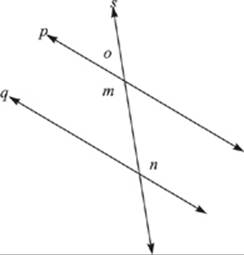
A. 25°
B. 65°
C. 115°
D. 130°
E. 140°
8. The volume of a cylinder is πr2h, where r is the radius of the base of the cylinder and h is the height of the cylinder. What is the volume, in cubic inches, of a cylinder of height 5 inches that has a base of radius 4 inches?
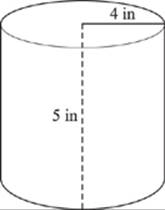
F. 9π
G. 20π
H. 40π
J. 80π
K. 100π
9. What is the value of |4 – x| if x = 7?
A. –11
B. –3
C. 3
D. 11
E. 47
10. In the figure below, where the triangle is created by 3 lines that intersect at the angles indicated, the measure of angle q = ?
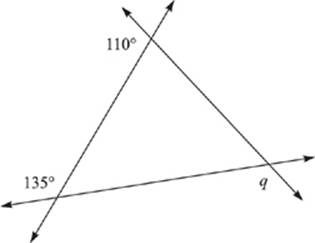
F. 45°
G. 65°
H. 70°
J. 110°
K. 115°
11. ![]()
A. ![]()
B. ![]()
C. ![]()
D. ![]()
E. ![]()
12. For all real numbers x and y, (x – 3y)2=?
F. 2x – 6y
G. x2 – 6xy + 9y2
H. x2 – 9y2
J. x2 – 9x2y2
K. x2 + 9xy + 9y2
13. If x is an odd integer greater than 5, what is the next greater odd integer in terms of x?
A. x + 2
B. x + 3
C. x + 5
D. 3x
E. x2
14. Which of the following has the same graph as x + 8y = 3?
F. 3x + 11y = 6
G. 2x + 10y = 5
H. 3x + y = 8
J. 3x + 24y = 9
K. x 8y = –3
15. Anne is 3 times as old as Kyle. If their combined age is 24, how old is Anne?
A. 24
B. 18
C. 12
D. 9
E. 6
16. In the figure below, the 2 intersecting lines QS and PT form triangles PRQ and SRT. Lines PQ and ST are parallel. If angle P is 65° and angle S is 85°, what is the measure of angle T ?
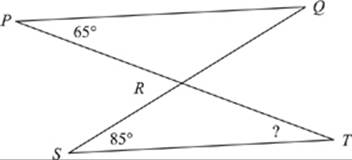
F. 45°
G. 55°
H. 65°
J. 75°
K. 85°
17. Carrie has $7 less than does her brother, Steve, who has d dollars. Carrie does not spend any money and earns $3. Which of the following is an expression for the amount of money, in dollars, that Carrie has?
A. (d – 7) + 2
B. d + 4
C. d – (7 + 3)
D. d – 4
E. d – 7
18. If 0.2a + 1.8 = a – 2.2, then a = ?
F. 4
G. 5
H. 8
J. 12
K. 20
19. Of the following, which is the smallest integer, x, satisfying the condition that ![]() is negative?
is negative?
A. 2
B. 3
C. 4
D. 5
E. 6
20. Jennifer cut a ribbon 30 inches long into 2 pieces. The ratio of the lengths of the 2 pieces is 2:3. What is the length, to the nearest inch, of the longer piece?
F. 5
G. 6
H. 12
J. 15
K. 18
21. A circle has an area of 49π. What is the diameter of the circle?
A. 7
B. 14
C. 24.5
D. 49
E. 153
22. What is the area, in square centimeters, of the figure shown below?
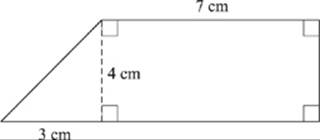
F. 21
G. 24
H. 34
J. 40
K. 84
23. For all positive a, b, and ![]()
A. ![]()
B. ![]()
C. ![]()
D. ![]()
E. ![]()
24. If ![]() is true, then x = ?
is true, then x = ?
F. 49
G. 21
H. 7
J. ![]()
K. 1
25. Which of the following gives the complete solution for the quadratic equation 3x2 = 4x?
A. ![]()
B. x = –3 or x = –4
C. ![]()
D. ![]()
E. ![]()
26. In the standard (x,y) coordinate plane, what is the slope of a line containing the points (3, –8) and (4,7)?
F. ![]()
G. –1
H. ![]()
J. 7
K. 15
27. In the standard (x, y) coordinate plane, which of the following is an equation of the circle with a center located at (2, –7) and a radius of 5?
A. (x + 2)2 + (y – 7)2 = 25
B. (x – 2)2 + (y + 7)2 = 25
C. (x – 2) + (y + 7) = 5
D. (x 7)2 + (y + 2)2 = 25
E. x2 + y2 = 25
28. If 8x2 – 8x – 6 = (ax – 3)(4x + a), what is the value of a?
F. –2
G. 1
H. 2
J. 3
K. 4
29. Which of the following is the slope-intercept form of a line that is perpendicular to ![]() in the standard (x, y) coordinate plane and that also contains the point (0, –5)?
in the standard (x, y) coordinate plane and that also contains the point (0, –5)?
A. y = 4x –5
B. ![]()
C. y = 4x + 5
D. ![]()
E. y = 5x + 4
30. When baking cookies, the quantity of flour needed is a constant proportion of the number of cookies being made. If 24 cookies require 2 cups of flour, how many cups of flour will 60 cookies require?
F. 2
G. ![]()
H. 3
J. ![]()
K. 5
31. What value of p will satisfy the equation 0.1(p + 1,800) = p?
A. 2,000
B. 1,620
C. 800
D. 200
E. 180
32. Which of the following is an equation of the circle shown below?
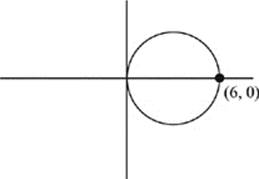
F. (x – 3)2 + y2 = 9
G. (x – 6)2 + (y – 3)2 = 9
H. x2 – (y – 6)2 = 3
J. x2 + (y + 3)2 = 9
K. (x – 3)2 + (y – 3)2 = 9
33. Which of the following is the solution statement for the inequality x + 2(5 – x)≤ 2x + 3?
A. x≤–7
B. x≥ ![]()
C. x ≥ 3
D. x≤ ![]()
E. x≥0
34. (4a4)4 is equivalent to:
F. a
G. 4a4
H. 16a8
J. 256a8
K. 256a16
35. Given the parallelogram below, what is the area of the shaded region?
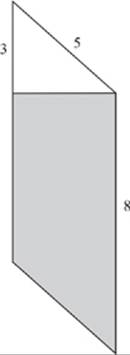
A. 24
B. 26
C. 32
D. 38
E. 40
36. What is the only possible solution for x in the equation ![]()
F. ![]()
G. ![]()
H. 3
J. ![]()
K. 5
37. Two similar isosceles right triangles are shown below. The hypotenuse of the smaller triangle is ![]() cm. If the perimeter of the larger triangle is twice that of the smaller triangle, what is the length, in centimeters, of each of the 2 congruent legs of the larger triangle?
cm. If the perimeter of the larger triangle is twice that of the smaller triangle, what is the length, in centimeters, of each of the 2 congruent legs of the larger triangle?
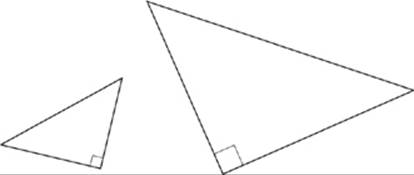
A. 2
B. 2![]()
C. ![]()
D. 4
E. ![]()
38. In the figure below, MNOQ is a parallelogram and OPQ is a right triangle. The side lengths shown are in centimeters. What is the area, in square centimeters, of figure MNOP?
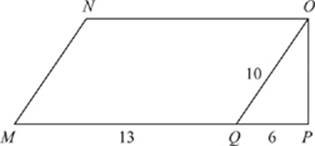
F. 104
G. 128
H. 136
J. 190
K. 208
39. In the triangle below, sin a =?
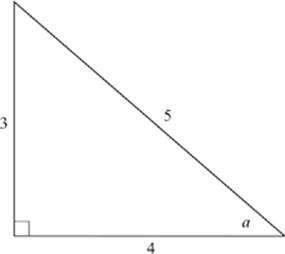
A. ![]()
B. ![]()
C. ![]()
D. ![]()
E. ![]()
40. If x = –3 and x = 5 are solutions to the equation (x + m)(x + n) = 0, then m + n = ?
F. –15
G. –8
H. –2
J. 2
K. 8
41. What is the x-coordinate if (x,5) is on a line that passes through (–2,–1) and (2,2) in the standard (x, y) coordinate plane?
A. –3
B. 4
C. 5
D. 6
E. 7
42. If cos ![]() and the sin
and the sin ![]() then tan B = ?
then tan B = ?
F. ![]()
G. ![]()
H. ![]()
J. ![]()
K. ![]()
43. Which of the following expressions is illustrated in the (x, y) coordinate plane below?
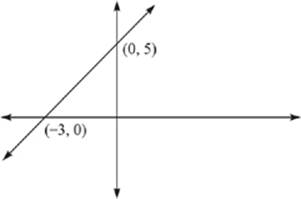
A. ![]()
B. ![]()
C. ![]()
D. ![]()
E. 5y – 3x = 0
44. The noncommon rays of 2 adjacent angles form a straight angle. The measure of one angle is twice the measure of the other angle. What is the measure of the smaller angle?
F. 45°
G. 55°
H. 60°
J. 65°
K. 90°
45. How many 3-letter orderings, where no letter is repeated, can be made using the letters of the word PONIES?
A. 6
B. 18
C. 30
D. 120
E. 216
46. Each side of a certain cube has a length of 5 centimeters. What is the volume of the cube, in cubic centimeters?
F. 35
G. 43
H. 53
J. 54
K. 63
47. For what values of x is 3x2 + 4x – 15 positive?
A. ![]()
B. x < –5 or x > 3
C. x < –3 or x > 3
D. x < 5 or x > –3
E. ![]()
48. Which of the following is a perfect square trinomial?
F. 4x2 + 12x + 9
G. 9x2 – 6x + 10
H. 2x2 + 4x + 16
J. 9x2 – 10
K. 4x2 + 16x + 4
49. Assuming both p and q are negative integers, if p = 2q, which of the following must be a rational number?
I. p + q
II. ![]()
III. ![]()
A. I only
B. II only
C. III only
D. II and III only
E. I, II, and III
50. Marcia rode her bike to Alan’s house. The trip to Alan’s house took x minutes. Returning home, Marcia was able to travel at an average speed 2 times faster than the speed at which she biked to Alan’s house. Which of the following is an expression for the total number of minutes Marcia biked on the entire trip?
F. 2x
G. ![]()
H. x + 2
J. ![]()
K. 3x
51. If s = 19 – (5 + r)3, for what real value of r will s have its maximum value?
A. 19
B. 5
C. 1
D. –5
E. –19
52. The figure below is a regular octagon. What is the measure of 1 of the interior angles of the octagon?
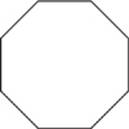
F. 45°
G. 60°
H. 90°
J. 120°
K. 135°
53. It is estimated that, from the beginning of 1995 to the end of 1999, the average number of CDs bought by teenagers increased from 5 per year to 9 per year. During the same time period, the average number of videogames purchased by teenagers increased from 2 per year to 10 per year. Assuming that in each case the consumption rates are the same, in what year did teenagers buy the same average number of CDs and videogames?
A. 1995
B. 1996
C. 1997
D. 1998
E. 1999
54. In the figure below, lines a and b are parallel and angle measures are as marked. If it can be determined, what is the value of x ?
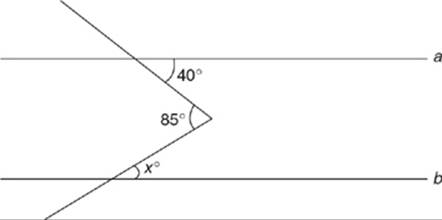
F. 40
G. 45
H. 50
J. 85
K. Cannot be determined from the given information
55. Which of the following is (are) equivalent to the mathematical operation a(b + c) for all real numbers a, b, and c?
I. ca + ba
II. ab + ac
III. (b + c)a
A. I only
B. II only
C. III only
D. I and II only
E. I, II, and III
56. For values of x where sin x, cos x, and tan x are all defined, ![]()
F. ![]()
G. cot x
H. 1
J. sin2 x
K. sec x
57. What is the solution set for the equation |x3| = –x3?
A. All real numbers
B. All x ≥ 0
C. All x ≤ 0
D. All odd numbers
E. Only x = 1
58. For which of the following values of c will there be 2 distinct solutions to the equation 3x2 + 2x + c = 0?
F. –1
G. 1
H. 2
J. 3
K. 4
59. In the figure below, angle QPR and angle PRS are right angles. If the length of line ![]() is 20 units and the length of line
is 20 units and the length of line ![]() is 12 units, what is the length of line
is 12 units, what is the length of line ![]()
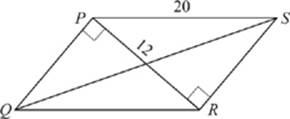
A. ![]()
B. 16
C. ![]()
D. ![]()
E. 20
60. The figure below shows a loading ramp at a hardware store that is s feet high and has a slope of t, where t > 0. Which of the following expressions gives the length of the ramp, in feet?
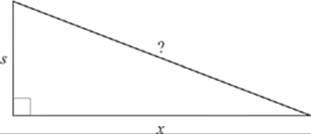
F. ![]()
G. t2 + s2
H. ![]()
J. ![]()
K. ![]()
END OF THE MATHEMATICS TEST
STOP! IF YOU HAVE TIME LEFT OVER, CHECK YOUR WORK ON THIS SECTION ONLY.
![]()
READING TEST
35 Minutes – 40 Questions
DIRECTIONS: This test includes four passages, each followed by ten questions. Read the passages and choose the best answer to each question. After you have selected your answer, fill in the corresponding bubble on your answer sheet. You should refer to the passages as often as necessary when answering the questions.
PASSAGE I
PROSE FICTION: This passage is adapted from “The Magic Shop,” by H. G. Wells, originally published in 1903.
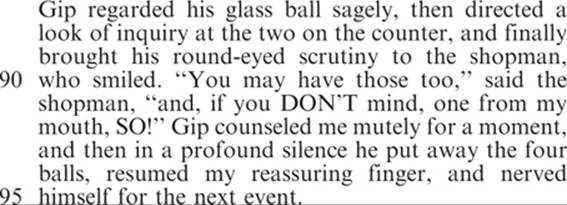
1. As it is used in the passage (line 15), the word fancied most nearly means:
A. forgotten.
B. imagined.
C. stated.
D. pretended.
2. It can be inferred from the passage that the narrator felt the magic shop’s location to be:
F. logical and commonplace.
G. strange and out of place.
H. fun and exciting.
J. warm and inviting.
3. The passage suggests that the narrator first learned about the Magic Shop:
A. when he had passed it before.
B. when Gip led him there.
C. when he was a little boy.
D. when he moved into the town.
4. The narrator states that Gip “did not propose to enter the shop or worry in any way” in the second paragraph. This description suggests that Gip:
F. was worried about his mother.
G. began to have a temper tantrum because he wanted to go into the store.
H. was not capable of speaking.
J. was a polite child.
5. The narrator considers the clerk’s behavior, as it is described in Paragraph 4, as:
A. surprising.
B. frightening.
C. confusing.
D. predictable.
6. Gip’s reaction to the shopman’s first trick can best be described as:
F. quietly astonished; he takes the glass balls and then goes back to holding his father’s hand.
G. uncomfortably disturbed; he signals to his father that he wishes to leave the shop.
H. obviously frustrated; he wants to know how the tricks are done.
J. unamused; he feels the shopman is playing tricks on him.
7. It can be inferred from the passage that the relation- ship between the narrator and his son is one best characterized by:
A. misunderstanding.
B. annoyance.
C. enjoyment.
D. patience.
8. It can be reasonably inferred that Gip’s feeling about entering the Magic Shop is:
F. frustration.
G. anxiety.
H. uncertainty.
J. excitement.
9. The description in Paragraph 4 suggests that the shopman’s sudden presence causes the narrator and his son to:
A. stop laughing together.
B. begin asking endless questions.
C. leave the shop.
D. laugh at him.
10. According to the last sentence in the passage, Gip was ready to:
F. start crying.
G. make his purchases.
H. run out of the store.
J. see the next trick.
PASSAGE II
SOCIAL SCIENCE: Alaska, the Beautiful?
11. As it is depicted in the passage, Alaska can most reasonably be characterized as:
A. an undeveloped territory with few resources.
B. a region of land that shouldn’t be a part of the United States.
C. a vast, unpopulated region that is difficult to visit.
D. a desolate region that encountered difficulty in achieving statehood.
12. As it is used in line 5, the word enigma most nearly means:
F. image.
G. mystery.
H. picture.
J. enemy.
13. Based on information in the passage, you can conclude that the author:
A. is almost 60 years old.
B. is a young girl.
C. was born in 1959.
D. is a resident of Alaska.
14. The author uses the statement “The Klondike Gold Rush in 1897 was probably the first concrete evidence that Alaska did have something to offer” (lines 32–34) most nearly to mean that:
F. gold was first discovered in North America in 1897.
G. governmental decisions influence economic developments.
H. before 1897, most people thought Alaska did not have any real value.
J. miners’ lives were made more difficult when they entered Alaska.
15. It can most reasonably be inferred that the author asks the question “So how did this vast and relatively untouched land …?” in Paragraph 2 in order to:
A. explain why Alaskans were determined to make their territory an official state.
B. introduce the rest of the information in the paragraph about Alaska’s struggle for statehood.
C. introduce arguments against Alaska’s chances at becoming a state.
D. elaborate on “Seward’s Folly.”
16. Which of the following statements best describes the author’s method of addressing her audience?
F. She makes an emotional appeal to the reader by describing her childhood.
G. She describes her personal experiences about her visits to Alaska.
H. She presents historical background information and personal opinion regarding the topic.
J. She presents a series of arguments similar to those presented when Alaskans were working toward statehood.
17. It is most reasonable to infer that when the author claims that “Alaska’s own natural wealth was being stripped for the benefit of a handful of outside entrepreneurs” in the third paragraph, she means that:
A. Alaska’s benefits to the rest of the country were short-lived.
B. Native Alaskans were greedy and did not want outsiders to settle there.
C. Native Alaskans were not reaping the benefits of their own land’s resources.
D. Native Alaskans did not believe in capitalism.
18. As it is used in line 72, the word propelled most nearly means:
F. motivated.
G. supported.
H. prospered.
J. silenced.
19. It can most reasonably be inferred that the author contrasts Alaska and Hawaii throughout the passage in order to:
A. show how much alike they really are.
B. encourage the reader to visit Hawaii.
C. provide a history of Alaska’s statehood.
D. emphasize her personal impressions of each state.
20. According to the author, Alaska’s eventual success at gaining statehood can mostly be attributed to:
F. the public’s growing desire to make it happen.
G. the bombing of Pearl Harbor.
H. the realization that Alaska had plenty of natural resources.
J. politicians who forced the issue against the people’s wishes.
PASSAGE III
HUMANITIES: Passage A is adapted from a biography of Ernest Hemingway. Passage B discusses one of Hemingway’s best known works.
PASSAGE A
PASSAGE B
Questions 21 – 23 ask about Passage A.
21. It can reasonably be inferred that the author includes lines 4–11 in order to suggest that Hemingway’s “image” and “genius” were both:
A. easy to achieve.
B. unnecessary to his success as a writer.
C. essential to creating his fame and fortune.
D. important components that helped shape the public’s perception of him.
22. All of the following are referred to in Passage A as support of Hemingway’s extensive publicity EXCEPT his:
F. acquisition of a fatherly persona.
G. Nobel Prize–winning achievements.
H. reputation as an action-oriented man.
J. tendency to spend time indoors with society’s elite.
23. The author of Passage A describes Hemingway’s feelings toward being an “indoor esthete” (lines 24–25) most likely in order to:
A. emphasize his hatred for that particular social group.
B. highlight his great sensitivity to the beauty of art and nature.
C. identify the factors that positively influenced his career as a writer.
D. describe the forces that caused him to rebel against standard conventions.
Questions 24 – 26 ask about Passage B.
24. In Passage B, the author’s attitude toward conventional interpretations of The Sun Also Rises (lines 57–58) suggests that:
F. the post–World War I generation felt that it could not function in society as it was.
G. literary critics are too focused on a common analysis to examine other viewpoints.
H. a striking inconsistency between reality and literature exists in Hemingway’s novel.
J. there is a link between the natural world and the themes found in Hemingway’s novel.
25. According to Passage B, Hemingway’s novel The Sun Also Rises has been interpreted in which of the following contexts?
I. Ecological values
II. Antiquated belief systems
III. Traditional pastoral conventions
A. I only
B. III only
C. I and III only
D. I, II, and III
26. Which individual would best illustrate the attitudes of the characters found in The Sun Also Rises?
F. A writer who feels comfortable in society and in large cities.
G. A mature person actively rebelling against society in 1920s Paris.
H. A young artist who feels at odds with society and finds peace in nature.
J. A middle-class person traveling Europe to learn more about World War I.
Questions 27 – 30 ask about both passages.
27. Hemingway’s “close contact” (lines 27–28) with nature described in Passage A is most closely associated with which consideration addressed in Passage B?
A. The relationship his characters had with urban life
B. The “presentation of rural life” (line 79) in his novel
C. An “intimate connection” (line 72) with the environment
D. The description of lives of people living in the countryside
28. A similarity between the two passages is that they both:
F. incorporate facts of Hemingway’s life.
G. examine the techniques Hemingway favored.
H. reveal the deep-seated issues that drove Hemingway to write.
J. assert that Hemingway was miscast as a member of the Lost Generation.
29. The information in Passage A supports which assumption about The Sun Also Rises as described in Passage B?
A. The main ideas found in Hemingway’s novel were formed from biblical interpretations.
B. Hemingway’s novel suggested that people who live in rural areas attain a better vision of life.
C. The novel was heavily influenced by Hemingway’s connection to nature and the environment.
D. The symbolism found in the novel is explicitly derived from nature, and avoids any connection to urban life.
30. With which of the following statements would the authors of both passages be most likely to agree?
F. Hemingway committed suicide.
G. Hemingway was a passionate writer.
H. Hemingway published only one book.
J. Hemingway limited his writing to nature themes.
PASSAGE IV
NATURAL SCIENCE: Dangerous Visitor
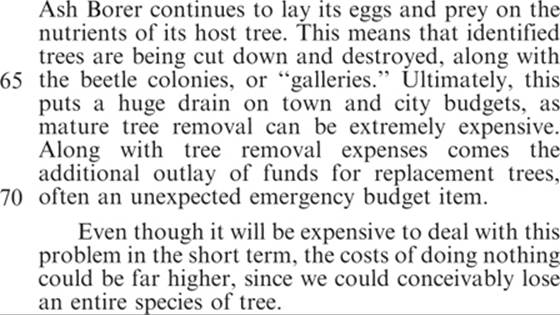
31. Information in the passage suggests that the author of the passage:
A. is a scientist researching EAB in Canada.
B. is cautiously optimistic about the success of EAB disease eradication.
C. is personally involved with the study of EAB disease in Michigan and Ohio.
D. disagrees with the outrageous fines for transporting firewood.
32. The passage indicates that, unlike some other insect infestations, Ash Borer infestations:
F. can be easily managed.
G. can be contained in a small area.
H. can be completely decimated in a short time.
J. can be difficult to identify and eradicate.
33. As it is used in line 33, the word monumental most nearly means:
A. serving as a monument.
B. historically significant.
C. exceptional in scope.
D. majestic.
34. The main worry expressed in the first paragraph is:
F. the cost of EAB infestation to the tree industry.
G. the transporting of EAB to American soil.
H. the time period during which the beetles were discovered.
J. the decimation of ash trees in North America.
35. The author’s attitude toward the study of EAB disease is best characterized as one of:
A. interested concern.
B. emotional panic.
C. scholarly interest.
D. scientific knowledge.
36. The passage identifies Agrilus planipennis as:
F. North American ash wood.
G. pest infestations.
H. beetle eggs.
J. Emerald Ash Borer beetle.
37. According to the passage, “galleries” are:
A. beetle colonies.
B. places from which to observe the beetles.
C. insecticide application processes.
D. infected trees.
38. The passage indicates that EAB beetles might also be correctly identified as:
F. a North American insect.
G. a Canadian beetle.
H. an Asian beetle.
J. Dutch elm beetles.
39. The passage states that EAB adults live:
A. under the tree bark of various local trees.
B. in the soil of the ash tree.
C. deep within the tree trunk.
D. in the upper branches of the ash tree.
40. The passage claims that one of the methods currently being used to control EAB disease is:
F. budget cuts.
G. tree removal.
H. insecticide spray.
J. tree decimation.
END OF THE READING TEST
STOP! IF YOU HAVE TIME LEFT OVER, CHECK YOUR WORK ON THIS SECTION ONLY.
![]()
SCIENCE TEST
35 Minutes – 40 Questions
DIRECTIONS: There are seven passages in this test. Each passage is followed by several questions. You should refer to the passages as often as necessary in order to choose the best answer to each question. Once you have selected your answer, fill in the corresponding bubble on your answer sheet. You may NOT use a calculator on this test.
PASSAGE I
Traditionally, oral drugs in pill or capsule form have been designed to release the dose of medicine in the upper gastrointestinal tract, where drugs are more readily dissolved and absorbed. New research has targeted the colon as an ideal environment for drug absorption to treat certain illnesses. To reach the colon, the drug must first pass through the stomach and small intestine. Table 1 details several drug-delivery systems.
The following experiments test two of the drug-delivery systems:
Experiment 1
Bacteria-dependent delivery. This experiment measured the average time it took a coated tablet to travel from the stomach (gastric emptying) through the small intestine (small intestine transit) to arrive in the colon. Twelve healthy men aged 23 to 25 years old and weighing between 55 and 70 kilograms (kg) who had fasted overnight were divided into 3 groups. They each swallowed 1 tablet, which contained a tracer (A or B) and 1 of 2 natural coatings (1 or 2). The location of the tracer was measured every half-hour for 12 hours. The average times are recorded in Table 2.

Experiment 2
Time-dependent delivery. The methods were the same as those used in Experiment 1, except that the tablets all contained the same tracer and 1 of 2 outer coatings (A or B) and 1 of 2 inner coatings (1 or 2). The average times are recorded in Table 3.

1. Based on Table 1, which drug-delivery system is most affected by food intake?
A. pH-dependent delivery
B. Time-dependent delivery
C. Pressure-dependent delivery
D. Bacteria-dependent delivery
2. According to Experiment 2, which combination of outer and inner coatings caused the tablet to reach its intended target most quickly?
F. A and 1
G. A and 2
H. B and 1
J. B and 2
3. The results of Experiment 1 suggest that:
A. the tracer affects the drug’s target destination more than the coating does.
B. the coating affects colonic arrival time.
C. the coating affects the drug’s target destination more than the tracer does.
D. the tracer affects gastric emptying time.
4. Which average time is standard for both experiments?
F. Small intestine transit time
G. Colonic arrival time
H. Small intestine transit time and colonic arrival time
J. Gastric emptying time
5. Which of the following is true about time-dependent delivery?
A. Synthetic polymers may be unsafe and may disintegrate in the stomach.
B. Taking food may disintegrate the capsule before it reaches the colon.
C. Delivery depends on the bacteria in the colon.
D. An inner barrier delays release of the medicine.
PASSAGE II
The process of altering solid rocks by changes in temperature, pressure, and chemistry is called metamorphism. Foliation refers to the alternating layers of different mineral compositions. Table 1 lists foliated and nonfoliated rocks. Table 2 shows a source rock and its result after undergoing metamorphism.
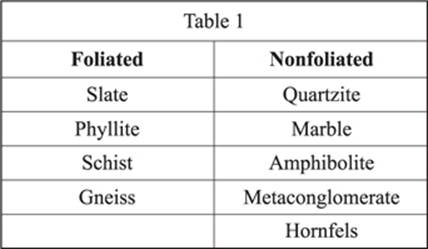
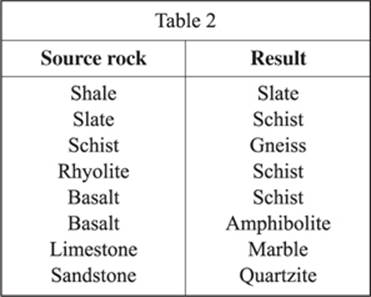
Figure 1 shows the metamorphic intensity of four types of rock.
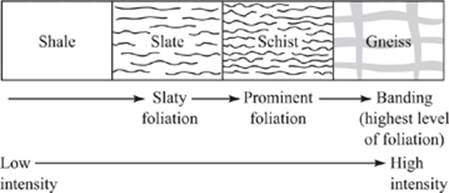
Figure 1
6. Which source rock’s metamorphic result can be either foliated or nonfoliated?
F. Shale
G. Granite
H. Schist
J. Basalt
7. According to the passage, the source rock for marble is:
A. shale.
B. sandstone.
C. limestone.
D. granite.
8. According to Figure 1, foliation:
F. increases as metamorphic intensity increases.
G. decreases as metamorphic intensity increases.
H. increases as metamorphic intensity decreases.
J. is not dependant on metamorphic intensity.
9. Based on the passage, which of the following statements is true?
A. Slate and gneiss form at approximately the same intensity.
B. Shale forms at a lower intensity than schist.
C. Basalt metamorphism results in only foliated rock.
D. Schist forms rhyolite at high metamorphic intensity.
10. According to Figure 1 and Table 2, it would be expected that:
F. foliation will increase during metamorphism from rhyolite to schist to gneiss.
G. foliation will decrease during metamorphism from shale to schist to gneiss.
H. metamorphic intensity will decrease from prominent foliation to banding.
J. metamorphic intensity will increase from prominent foliation to slaty foliation.
11. According to the passage, schist can result from which of the following source rocks?
A. Slate only
B. Slate, Shale, and Basalt
C. Slate, Rhyolite, and Basalt
D. Slate and Basalt only
PASSAGE III
Researchers interested in studying the effect of two different solvents on the rate of solvation (chemical process involving the interaction of a solvent and a solute) conducted two experiments. The results are shown below.
A tablet containing 1,285 milligrams (mg) sodium bicarbonate and 1,000 mg citric acid was placed in each of six, 250 milliliter (mL) beakers. The tablets were either whole, crushed into a coarse powder, or crushed into a fine powder. Either 150 mL of water or 150 mL of ethanol was added to each beaker. The time it took the tablet to dissolve was recorded.
Experiment 1
Each 250 mL beaker contained a tablet (1,285 mg sodium bicarbonate and 1,000 mg citric acid), which was either whole or crushed. 150 milliliters of water or ethanol was added to each beaker, and the time it took in seconds (s) for the tablet to dissolve was recorded in Table 1.
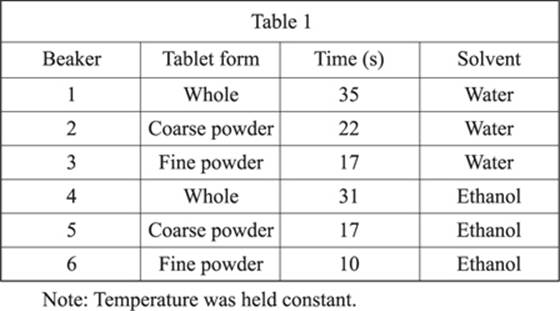
Experiment 2
To each of the 6 beakers, 1 whole tablet (containing 1,285 mg sodium bicarbonate and 1,000 mg citric acid) was added. Fifteen milliliters of water of varying temperatures was added to the beakers, and the time it took in seconds (s) for the tablet to dissolve was recorded in Table 2.
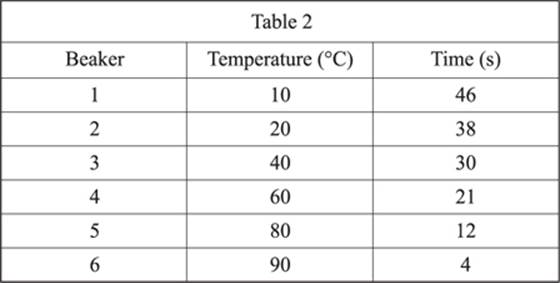
12. In Experiment 1, which of the following scenarios caused the tablet to dissolve the fastest?
F. Fine powder in water
G. Coarse powder in ethanol
H. Fine powder in ethanol
J. Coarse powder in water
13. In what ways are the methods of Experiments 1 and 2 different?
A. The solvent was varied in Experiment 1 but held constant in Experiment 2.
B. The temperature was varied in Experiment 1 but held constant in Experiment 2.
C. The tablet type was varied in Experiment 2 but held constant in Experiment 1.
D. The solvent was varied in Experiment 2 but held constant in Experiment 1.
14. What observation can be made from the data in Table 1?
F. Crushing the tablet does not affect dissolution time.
G. Solvents do not affect dissolution time.
H. Crushing the tablet results in slower dissolution time.
J. Crushing the tablet results in faster dissolution time.
15. What would the result most likely be if 150 mL of 80°C water was added to a beaker containing a finely crushed tablet?
A. The dissolution rate would be slower than 17 seconds.
B. The dissolution rate would be faster than 12 seconds.
C. The dissolution rate would be slower than 12 seconds.
D. Crushing the tablet would have no effect on dissolution rate.
16. Based on the experiments, what can be done to slow the dissolution rate?
F. Increase the water temperature
G. Crush the tablet
H. Use ethanol to dissolve the tablet
J. Decrease the water temperature
17. Based on the experiments, which method resulted in the slowest dissolution rate?
A. Whole tablet dissolved in 10°C water
B. Finely crushed tablet dissolved in 25°C water
C. Finely crushed tablet dissolved in ethanol
D. Whole tablet in 80°C water
PASSAGE IV
A biologist wanted to test the effects of nutrition on the growth of young rats. Two experiments were conducted using different feeds and vitamin supplements. For both experiments, 4 groups of 20 rats each were given a different type of feed over a 6-week period. The rats were measured and weighed weekly. The rats in each group had an average starting weight of 200 grams (g) and an average starting length of 10 centimeters (cm).
Experiment 1
• Group 1 was fed a high-protein feed (Feed W).
• Group 2 was fed a grain-based feed with vitamin supplements (Feed X).
• Group 3 (control group) was fed a grain-based feed without supplements (Feed Y).
• Group 4 was fed a grain-based feed without supplements plus fruits and vegetables (Feed Z).
The results and average measurements are recorded in Table 1.
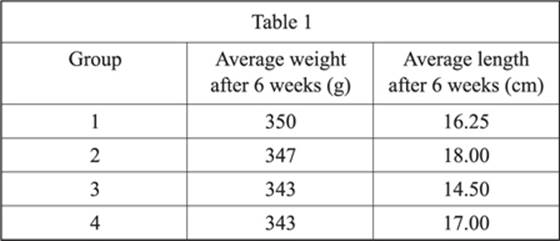
Experiment 2
• Group 5 was fed a high-protein feed plus fruits and vegetables (Feed M).
• Group 6 was fed a grain-based feed with vitamin supplements plus fruits and vegetables (Feed N).
• Group 7 (control group) was fed a grain-based feed without supplements (Feed O).
• Group 8 was fed a grain-based feed without supplements plus fruits and vegetables (Feed P).
The results and average measurements are recorded in Table 2 below.
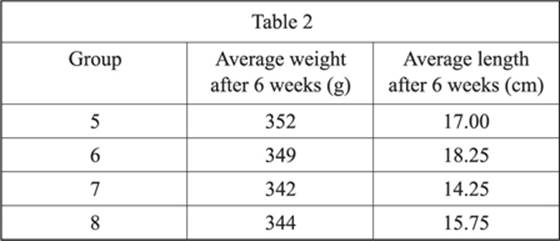
18. Based on the results of both experiments, the rats in which group increased the most in average length?
F. Group 6
G. Group 2
H. Group 7
J. Group 4
19. Based on the results of Experiment 2, which feed resulted in the greatest weight gain?
A. Feed M
B. Feed N
C. Feed O
D. Feed P
20. Based on the results of both experiments, the rats in which of the following groups gained the least amount of weight?
F. Group 1
G. Group 3
H. Group 5
J. Group 7
21. If the biologist added vitamin supplements to Feed M for a new group (Group 9), what might the result be after 6 weeks?
A. Group 9 would weigh less than Group 5.
B. Group 9 would weigh less than Group 6.
C. Group 9 would have a greater length than Group 5.
D. Group 9 would have a shorter average length than Group 5.
22. Which of the following statements is true, according to Table 2?
F. Feed N produces rats that are almost twice as long as those in the control group.
G. Feed M produces rats that weigh 3 times as much as those in the control group.
H. Feed P produces rats with the greatest average length.
J. Feed O produces rats similar to those produced by Feed P.
PASSAGE V
Igneous rocks are formed by the cooling and solidification of molten magma either above ground, when magma, or lava, reaches the Earth’s surface and cools, or deep below the surface of the Earth, when magma gets trapped in small pockets and cools. Table 1 lists rock textures and cooling characteristics of igneous rocks. Figure 1 shows the cooling rate and associated grain size of igneous rock textures. Table 2 lists igneous rocks and their respective textures.

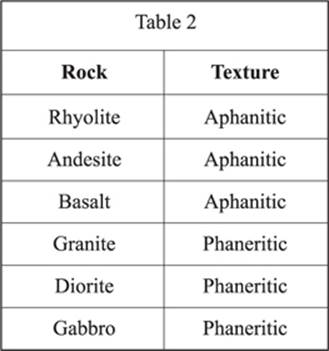
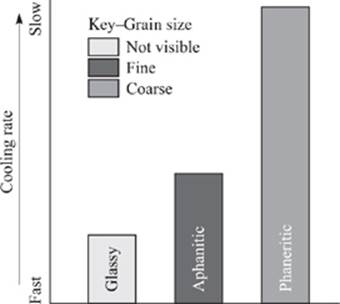
Figure 1
23. Which of the following is true about granite?
A. It is fine-grained and cools slowly.
B. It is fine-grained and cools quickly.
C. It is coarse-grained and cools quickly.
D. It is coarse-grained and cools slowly.
24. Rhyolite and andesite have which of the following in common?
F. They cool very slowly at a uniform rate.
G. They are phaneritic.
H. They cool quickly but more slowly than glassy rocks.
J. They are coarse-grained.
25. Using the data in Table 1 and Figure 1, what conclusion can be made about (crystal) grain size?
A. The slower a rock cools, the larger the crystals will be.
B. The faster a rock cools, the larger the crystals will be.
C. Glassy rocks have large crystals.
D. The slower a rock cools, the smaller the crystals will be.
26. Which rock texture is formed by rapid cooling from a high temperature?
F. Porphyritic
G. Glassy
H. Phaneritic
J. Aphanitic
27. Based on information in the passage, which rocks cooled quickly?
A. Rhyolite, granite, and diorite
B. Granite, gabbro, and peridotite
C. Rhyolite, andesite, and basalt
D. Andesite, basalt, and granite
28. Peridotite is an igneous rock with interlocking grains that can be seen without a microscope. What are the likely cooling characteristics of peridotite?
F. It cools quickly.
G. It cools at a very slow and uniform rate.
H. It cools slowly at first, and then speeds up.
J. It cools at a rapid, constant rate.
PASSAGE VI
Stars can be classified according to color, surface temperature, mass, radius, and luminosity. Table 1 shows the spectral classification of star types. Figure 1 is a cluster diagram plotting stars near the sun by temperature and luminosity (total brightness). Main sequence stars are young stars shown in Figure 1 as the central band.
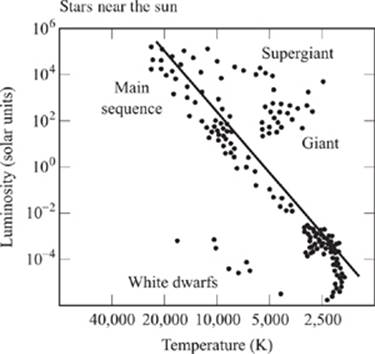
Figure 1
29. According to Table 1, which type of star has a mass 18 times that of the sun?
A. O
B. B
C. F
D. K
30. What color are stars with an approximate surface temperature of 2,500 K?
F. Blue
G. White
H. Yellow
J. Red
31. What is the color range of the giant stars shown on Figure 1?
A. Orange to red
B. Blue to white
C. White to yellow
D. Blue to orange
32. The main sequence stars in Figure 1 represent all the star types EXCEPT:
F. M
G. A
H. O
J. K
33. A new star with a temperature of 15,000 K and luminosity of 10—4 solar units is plotted in Figure 1. Based on the passage, what category of star is it?
A. Main sequence
B. White dwarf
C. Supergiant
D. Giant
PASSAGE VII
A student wanted to test the absorbency of several brands of cat litter to determine which absorbed water the fastest. The student conducted two experiments to test the litters.
Experiment 1
The student filled nine 12-inch × 9-inch glass pans 2 inches deep with 1 of 3 types of cat litter (A, B, or C). The student placed each type of litter in 3 areas with different relative humidity levels. The student then poured 100 milliliters (mL) of water into each pan. The student recorded the time it took for each pan of litter to absorb the water. Results are shown in Table 1.

Experiment 2
The student repeated the previous experiment but used only 3 pans (one of each litter) and added 4 ounces of baking soda (sodium bicarbonate) to each pan. The student mixed the litter and baking soda thoroughly before adding 100 mL of water to each pan. The room had a constant relative humidity of 40% during the experiment. Results are shown in Table 2.
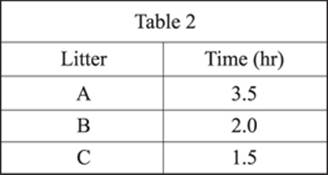
34. Based on the experiments, which type of litter absorbs water fastest at 40% relative humidity?
F. Litter A + baking soda
G. Litter C
H. Litter B
J. Litter C + baking soda
35. If the relative humidity was increased to 90%, how long might Litter B take to absorb all of the water?
A. 5 hours
B. 7 hours
C. 9 hours
D. >9 hours
36. Based on the results of Experiment 1, which of the following is true of Litter A?
F. It took almost twice as long as Litter B and more than 3 times as long as Litter C to absorb the water at 80% relative humidity.
G. It absorbed the water almost twice as fast as Litter B and almost 3 times as fast as Litter C at 80% humidity.
H. It absorbed the water faster than both Litter B and Litter C.
J. It absorbed the water faster than Litter B at 60% relative humidity.
37. How does Experiment 1 differ from Experiment 2?
A. Baking soda was added to the litter in Experiment 1.
B. The amount of water varied in Experiment 2.
C. Relative humidity is constant in Experiment 2 but varies in Experiment 1.
D. Relative humidity is constant in Experiment 1 but varies in Experiment 2.
38. How did adding baking soda affect the water absorption times of the litter?
F. It decreased the absorption time for Litter A only.
G. It increased the absorption time for Litter A and Litter B.
H. It decreased the absorption time for Litter B only.
J. It increased the absorption time for Litter B and Litter C.
39. If the student were to repeat Experiment 2, but reduced the quantity of water added by 50%, how would the absorption time most likely be affected?
A. It would stay the same for all litter types.
B. It would decrease for Litter A only.
C. It would increase for all litter types.
D. It would decrease for all litter types.
40. According to the results of the experiments, which of the following conclusions can be reached?
F. Relative humidity levels have no effect on absorption rates.
G. Absorption time will decrease at higher relative humidity levels for all litter types.
H. The type of litter has the greatest effect on absorption rates at all relative humidity levels.
J. Adding baking soda to cat litter increases the absorption rate for all litter types.
END OF THE SCIENCE TEST
STOP! IF YOU HAVE TIME LEFT OVER, CHECK YOUR WORK ON THIS SECTION ONLY.
WRITING TEST PROMPT
DIRECTIONS: This test is designed to assess your writing skills. You have forty (40) minutes to plan and write an essay based on the stimulus provided. Be sure to take a position on the issue and support your position using logical reasoning and relevant examples. Organize your ideas in a focused and logical way, and use the English language to clearly and effectively express your position.
When you have finished writing, refer to the Scoring Rubrics discussed in Chapter 7 to estimate your score.
Note: On the actual ACT you will receive approximately 2.5 pages of scratch paper on which to develop your essay, and approximately 4 pages of notebook paper on which to write your essay. We recommend that you limit yourself to this number of pages when you write your practice essays.
EARLY CHILDHOOD TECHNOLOGY USE
Electronic devices with viewing screens are ubiquitous in modern society. Most people have smartphones with them at all times and many also carry laptop computers or tablets with them nearly everywhere. Almost every desk has a computer on it, and televisions are everywhere in homes and public spaces. Nearly from birth, children are exposed to screens that attract their attention and focus. There is much discussion among parents and child development experts regarding the impact of this electronic revolution on young children.
Perspective One
Electronic devices are a fact of life and will certainly be important in the future. Children who adapt to them early will have an advantage later in life. Not only should children become comfortable with screened devices, they should be taught keyboard skills and even basic coding as part of their early-childhood language development.
Perspective Two
Children place many demands on their parents’ time and energy. Young children need constant supervision and stimulation. So long as parents are responsible about content, it is understandable when they use television and other devices as a means to focus their children and keep them still and quiet for reasonable periods of time.
Perspective Three
Children who view electronic screens at a young age often exhibit negative traits, such as inability to focus for appreciable periods of time, near sightedness, and decreased ability to recognize emotions in other human beings. They also tend to be less physically active and more obese. Parents often fail to adequately monitor children’s use of technology, leading to elevated stress and even thought disorders.
Essay Task
Write a unified, coherent essay in which you evaluate multiple perspectives on the implications of early childhood technology use. In your essay, be sure to:
• analyze and evaluate the perspectives given
• state and develop your own perspective on the issue
• explain the relationship between your perspective and those given
Your perspective may be in full agreement with any of the others, in partial agreement, or wholly different. Whatever the case, support your ideas with logical reasoning and detailed, persuasive examples.
![]() ANSWER KEY
ANSWER KEY
English Test
1. A
2. F
3. C
4. G
5. A
6. F
7. C
8. H
9. D
10. H
11. B
12. F
13. A
14. H
15. D
16. H
17. B
18. G
19. C
20. J
21. C
22. J
23. A
24. J
25. D
26. H
27. A
28. J
29. B
30. F
31. C
32. F
33. B
34. J
35. A
36. G
37. B
38. J
39. C
40. G
41. B
42. J
43. C
44. F
45. D
46. F
47. B
48. G
49. C
50. H
51. D
52. F
53. B
54. F
55. C
56. H
57. A
58. F
59. C
60. H
61. D
62. H
63. D
64. F
65. A
66. G
67. D
68. G
69. C
70. F
71. D
72. H
73. C
74. G
75. D
Mathematics Test
1. D
2. H
3. E
4. H
5. D
6. F
7. B
8. J
9. C
10. K
11. D
12. G
13. A
14. J
15. B
16. H
17. D
18. G
19. A
20. K
21. B
22. H
23. D
24. J
25. D
26. K
27. B
28. H
29. A
30. K
31. D
32. F
33. B
34. K
35. B
36. K
37. D
38. G
39. A
40. H
41. D
42. F
43. A
44. H
45. D
46. H
47. E
48. F
49. E
50. J
51. E
52. K
53. D
54. G
55. E
56. F
57. C
58. F
59. B
60. K
Reading Test
1. B
2. G
3. A
4. J
5. A
6. F
7. C
8. J
9. A
10. J
11. D
12. G
13. A
14. H
15. B
16. H
17. C
18. F
19. D
20. F
21. B
22. F
23. D
24. F
25. C
26. G
27. D
28. H
29. B
30. H
31. B
32. J
33. C
34. J
35. A
36. J
37. A
38. H
39. D
40. G
Science Test
1. C
2. G
3. B
4. J
5. D
6. J
7. C
8. F
9. B
10. F
11. C
12. H
13. A
14. J
15. B
16. J
17. A
18. F
19. A
20. J
21. C
22. J
23. D
24. H
25. A
26. G
27. C
28. G
29. B
30. J
31. A
32. H
33. B
34. G
35. D
36. F
37. C
38. F
39. D
40. H
![]() SCORING GUIDE
SCORING GUIDE
Your final reported score is your COMPOSITE SCORE. Your COMPOSITE SCORE is the average of all of your SCALED SCORES.
Your SCALED SCORES for the four multiple-choice sections are derived from the Scoring Table on the next page. Use your RAW SCORE, or the number of questions that you answered correctly for each section, to determine your SCALED SCORE. If you got a RAW SCORE of 60 on the English test, for example, you correctly answered 60 out of 75 questions.
Step 1 Determine your RAW SCORE for each of the four multiple-choice sections:
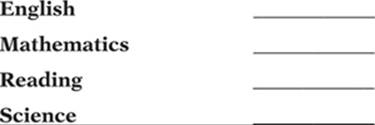
The following Raw Score Table shows the total possible points for each section:
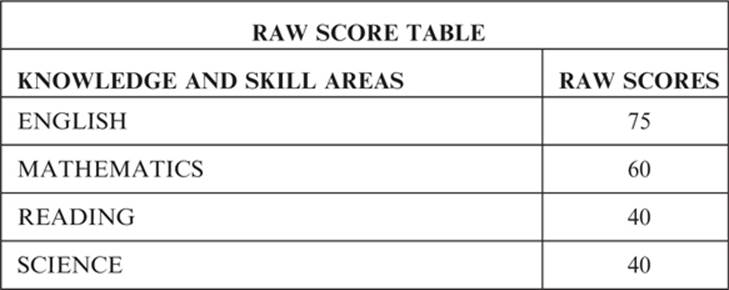
Multiple-Choice Scoring Worksheet
Step 2 Determine your SCALED SCORE for each of the four multiple-choice sections using the following Scoring Worksheet. Each SCALED SCORE should be rounded to the nearest number according to normal rules. For example, 31.2 ≈ 31 and 31.5 ≈ 32. If you answered 61 questions correctly on the English section, for example, your approximate SCALED SCORE would be 29.
If you take the optional Writing Test, you should refer to Chapter 7 for guidelines on scoring your Writing Test Essay.
Step 3 Determine your COMPOSITE SCORE by finding the sum of all your SCALED SCORES for each of the four sections: English, Mathematics, Reading, and Science, and divide by 4 to find the average. Round your COMPOSITE SCORE according to normal rules. For example, 31.2 ≈ 31 and 31.5 ≈ 32.

![]() ANSWERS AND EXPLANATIONS
ANSWERS AND EXPLANATIONS
English Test Explanations
PASSAGE I
1. The best answer is A. The underlined portion is clear and concise and written in active voice. Answer choices B and D are awkward and not grammatically correct. Answer choice C is written in the passive voice.
2. The best answer is F. This question requires you to punctuate the underlined portion correctly. Because the adverb perfectly directly modifies the adjective erect, you should not separate the words with a comma. Eliminate answer choice H. You should, however, use a comma to separate the two clauses in the sentence.
3. The best answer is C. In order to maintain parallel structure in the paragraph, verb forms must match. The verbs watch, remains, and curls are all in the simple present tense. The subject is the third-person, singular pronoun he. Therefore, you should use the third-person, singular, simple present tense verb appears, answer choice C.
4. The best answer is G. The subordinate clause that introduces this sentence refers to the age of the dog. The appropriate subordinating conjunction to use with time is when, answer choice G. Careful reading of the other answer choices within the sentence reveals that they do not make sense.
5. The best answer is A. As it is written, the underlined portion provides detailed information about what the mother and her son would find in the nursery. The other answer choices are somewhat vague and nonspecific.
6. The best answer is F. The singular verb was follows the singular pronoun he; this sentence is grammatically correct as it is written. Eliminate answer choices G and J, which are plural verb forms. Because this action took place in the past, you can also eliminate answer choice H, which is present.
7. The best answer is C. This question requires you to determine the correct punctuation. Eliminate answer choice D because it creates an incomplete sentence. A semicolon should be followed by an independent clause, so eliminate answer choice B. To separate independent clauses linked by a coordinating conjunction such as and, a comma must precede the coordinating conjunction. In addition, no comma should come between the conjunction and the subject of the second clause. Eliminate answer choice A.
8. The best answer is H. The verb are in this sentence takes a conjoined predicate. Therefore, in this case, the forms of the adjectives on either side of the conjunction and must be parallel. Held is an adjective and a past participle. Raising, from answer choice F, is a gerund, so eliminate it. Answer choice G has risen, which is the past participle of rise, a different verb. With the auxiliary verb have, it is awkward in the sentence. Eliminate answer choice G. Eliminate answer choice J because the paragraph is in the present tense.
9. The best answer is D. The paragraph is in the present tense, so references to completed actions in the past (like this one about training the dog) should be made in the simple past tense.
10. The best answer is H. The best way to answer this question is to try the answer choices in the sentence. The only one that does not make sense and is, therefore, NOT a good alternative, is answer choice H. It is too wordy and awkward.
11. The best answer is B. At this point (after a subordinate clause and a comma), you may be tempted to begin the main clause with a subject and a verb. Notice, however, that the main clause is already present in the underlined portion for Question 12. Therefore, eliminate answer choice D. Eliminate answer choice C because it contains the third-person, singular verb form marvels, which has no clear subject. Eliminate answer choice A for the same reason. Answer choice B is best because a gerund phrase is appropriate before the main clause.
12. The best answer is F. The underlined portion makes the most sense where it is. Placing it anywhere else in the sentence would create confusion as to who is doing the watching and marveling.
13. The best answer is A. The context of the paragraph indicates that the dog is excited and happy to be returning to its owner. The phrase that best conveys that idea is races back, which is the original version. The other answer choices are not supported by the context of the paragraph.
14. The best answer is H. The underlined portion, “happy to be alive,” indicates the dog’s perceived attitude toward returning to its owner. If this part of the sentence were deleted, the sentence would lose its description of the dog’s attitude. Therefore, answer choice H is best.
15. The best answer is D. This question requires you to determine the main idea of the passage. The passage is primarily about the writer’s experience with her dog, not about training her dog to hunt. You can eliminate answer choices A and B. There is nothing in the passage that encourages readers not to train dogs to hunt, so eliminate answer choice C.
PASSAGE II
16. The best answer is H. First, no comma should separate the prepositional phrase of the fence from the noun it modifies, issue. Second, no comma should separate the preposition of from its object, the fence.
17. The best answer is B. This choice contains a comma splice. You cannot separate two independent clauses with a comma. The remaining answer choices are grammatically correct.
18. The best answer is G. This paragraph is written in the simple present tense. Therefore, to maintain parallelism among the verbs, the simple present form dictates is appropriate here.
19. The best answer is C. In this sentence, the privacy belongs to the subject people. (The possessive determiner their before privacy has people as its antecedent.) The context of the passage supports the idea people value their own privacy.
20. The best answer is J. The underlined portion is unnecessary and should be omitted.
21. The best answer is C. The first step in answering this question is to decide whether to use then or than. The word then indicates the passage of time, which is not appropriate here. Eliminate answer choices A and D. Now look at the punctuation. It is not necessary to include a comma after the word rather, so eliminate answer choice B.
22. The best answer is J. This question requires you to determine the correct use of commas. It is necessary to set off each item in a list with a comma. Therefore, you should place a comma after trees, shrubs, vines, answer choice J.
23. The best answer is A. The phrase which lose their foliage includes important information regarding deciduous trees. Because the foliage belongs to the trees, use the plural possessive pronoun their, not the contraction of they are. It is also necessary to use which to set off the restrictive clause, lose their foliage.
24. The best answer is J. This question requires you to choose the best preposition. The best one to use with the noun protection (or the verb protect, which is its root) is against. Answer choices F and G can be eliminated because they indicate that the prying eyes and perked ears are the ones being ineffectively protected. Answer choice H, toward, is a preposition with meanings related to directional motion, so it is not appropriate here.
25. The best answer is D. The preceding sentence states that deciduous trees... prove to be ineffective… The next sentence presents the better alternative, evergreen trees. The function of this sentence is clear, so it is wordy to refer to deciduous trees again.
26. The best answer is H. This question requires you to determine the correct use of commas. An intercepting phrase such as for example needs to be set off with commas. That is, you should place a comma before and after the phrase, as in answer choice H.
27. The best answer is A. The main point of the passage is that fences can provide privacy and security. The other answer choices are not supported by the context of the passage.
28. The best answer is J. Because the word carefully is used in the sentence and is not part of the underlined portion, you should not use words such as cautious and cautiously, or phrases like take care. Answer choices F, G, and H create redundancy.
29. The best answer is B. Adding an s forms the plural form of neighbor. The sentence does not indicate any possession, so eliminate answer choices A and C. It is generally not appropriate to add s’s to create plural possession, so answer choice D should never be a credited response.
30. The best answer is F. First, you can eliminate answer choice G because full of cost is not idiomatic. Among answer choices F, H, and J, answer choice F conveys that idea most simply. (Note that costly is an adjective and not an adverb, despite the suffix –ly.)
PASSAGE III
31. The best answer is C. It is necessary to separate all of the items in the list with commas.
32. The best answer is F. The pronoun that correctly replaces the antecedent terms.
33. The best answer is B. This question requires you to express the idea clearly and simply. Since the passage indicates that the book is about Maya Angelou’s childhood, eliminate answer choice C. Eliminate answer choice D because it creates an awkward sentence. Answer choices A and B say essentially the same thing, but answer choice B is less awkward and wordy.
34. The best answer is J. Answer choice J creates an incomplete sentence, so it would NOT be an acceptable alternative to the underlined portion.
35. The best answer is A. The sentence indicates that, after a certain traumatic incident, Maya did not speak for five years. It is important to have some explanation for her behavior. If that phrase were deleted, you would not have a clear picture of why Maya spent the next five years in total and utter silence.
36. The best answer is G. Different can be deleted because it is redundant with variety. The other words have important roles in the sentence.
37. The best answer is B. When two verb phrases are conjoined as they are here with and, no comma is needed. Note that there is no separate subject for the second verb phrase, in which case a comma would be needed. Furthermore, civil rights movement is a noun phrase that should not be punctuated, so answer choices C and D can be eliminated.
38. The best answer is J. This paragraph mentions Angelou’s professional accomplishments. The new sentence is about salary, which distracts from the author’s intent to dignify the poet. It adds little interest to the passage.
39. The best answer is C. The President’s name is irrelevant and does not add any necessary information to the passage.
40. The best answer is G. You would either listen to or watch. You would not watch to, so eliminate answer choices F and J. Answer choice J also includes an unnecessary comma. You would not watch with, so eliminate answer choice H.
41. The best answer is B. It is important to maintain parallel structure within the sentence. Since the cannons are deafening, the flowers must be blossoming, answer choice B.
42. The best answer is J. This question tests your ability to express an idea clearly and simply. Maya Angelou is to instill the sense of wonder and joy, so that phrase should directly follow her name in the sentence. She does not sense the wonder and joy, so eliminate answer choice F. Answer choices G and H are awkward and should be eliminated as well.
43. The best answer is C. This question requires you to select the correct verb form. The sentence as written does not clearly indicate what Angelou has the ability to do, so eliminate answer choice A. The prepositions for and with do not complement the noun ability, so their meaning is unclear. Eliminate answer choices B and D. One way to complement ability appropriately is with a verb in the infinitive form, as in answer choice C.
44. The best answer is F. The sentence does not specify one particular listener, but instead refers to anyone who listens to Maya Angelou. Answer choice H is wordy and awkward, and should also be eliminated. If you omit the underlined portion, the relative pronoun that becomes ambiguous.
45. The best answer is D. This question requires you to determine the main idea of the essay. While the essay mentions that Maya Angelou had a difficult childhood, it in no way focuses on southern poverty, so eliminate answer choices A and B. The main focus of the passage is Maya Angelou’s life in general.
PASSAGE IV
46. The best answer is F. Answer choices G and J are wordy and can be eliminated. Answer choice H is awkward and can be eliminated because it seems to repeat what has already been stated in the sentence.
47. The best answer is B. The prepositional phrase to the nearest shopping center is a complement of the verb go. Therefore, no punctuation is needed in the underlined portion.
48. The best answer is G. Because this essay is a reflection of past events, you should use the pasttense verb seemed; eliminate answer choices F, H, and J.
49. The best answer is C. Sentence 4 introduces the idea that the writer’s mother would receive the fabric. Sentence 5 then indicates that much of the material would be turned into the writer’s school clothes. It makes the most sense to place the new sentence between Sentences 4 and 5.
50. The best answer is H. The preposition because implies that one thing happened as the result of another. In this sentence, the result of the writer spending most of her time with her grandmother is that she really remembers the brief moments that she shared with her grandfather. The other answer choices are not supported by the context of the essay.
51. The best answer is D. Answer choice D is NOT acceptable because it lacks an action verb. All other answer choices have the verb are.
52. The best answer is F. The writer indicates that her grandfather always seemed to be in and out, but mostly out. This suggests that he was gone much of the time. The other answer choices are not supported by the context of the essay.
53. The best answer is B. Since the subject the chair and ottoman, is a plural subject, you must use a plural verb. Eliminate answer choice A. Also, like the rest of the passage, a past-tense form of the verb should be used. Eliminate answer choices C and D.
54. The best answer is F. This question tests your ability to express an idea clearly and simply. The sentence makes it clear that when the writer’s grandfather was away on a fishing trip, the chair and ottoman were still forbidden. While answer choice H is grammatically correct, it is too wordy and awkward, and is, therefore, not the best choice.
55. The best answer is C. Answer choice A has a dangling modifier; the phrase even as a child should refer to the author, not Grandpa. Eliminate answer choice A. Answer choice B contains awkward word order, so eliminate it. Answer choices C and D are both grammatically correct, but answer choice C is made clearer with the subject pronoun I and by its standard word order.
56. The best answer is H. This question requires you to express an idea clearly and simply. Since a king by definition is royal, you do not need to use both words in the same phrase. Eliminate answer choices F and J. It is not correct to say a royalty in this case, so eliminate answer choice G.
57. The best answer is A. The underlined portion effectively describes the conditions under which the writer’s grandpa made his fishing lures. Placing the phrase elsewhere in the sentence would create awkwardness.
58. The best answer is F. In order to maintain parallel structure within this sentence, the verbs should match. Since the writer says that her grandfather would invite her to the garage, the sentence should say that he would show her how to tie the fishing lure together, answer choice F. Eliminate answer choice G because it creates a comma splice.
59. The best answer is C. Although the answer choices seem to indicate that this is a pronoun/antecedent agreement question, it is more a question about tense. The introductory phrase by then triggers the past perfect tense because it points to a time in the past before another time of reference in the past. (The move to the country occurred before the summer visits ended.) Therefore, answer choice C, with had, is best. Answer choice A has passive voice, which is rarely the best choice. Answer choice B creates the simple past tense, which is not correct. The pronoun it in answer choice D is ambiguous, so eliminate it.
60. The best answer is H. This question requires you to determine the main idea of the essay. The essay is primarily about the writer’s experiences at her grandparents’ house. It does not mention the relationship that her grandparents had with each other, so eliminate answer choices F and G. While it is true that the writer spent more time with her grandmother, this is off-topic and does not effectively answer the question.
PASSAGE V
61. The best answer is D. This question requires you to recognize redundancy. Because jointly, with each other, and together all have the same meaning, it is not necessary to use more than one of them in the sentence. Eliminate answer choices A, B, and C.
62. The best answer is H. The passage includes information about the importance of the electric motor, so the most appropriate word choice would be important. The other answer choices are not supported by the context of the passage.
63. The best answer is D. The sentence as written contains a split infinitive. (The adverbial phrase more efficiently falls between the particle to and the base-form verb separate.) Eliminate answer choice A. Eliminate answer choice B because it uses the gerund form incorrectly. Eliminate answer choice C because it contains the singular verb separates instead of the bare form separate to form the infinitive with to.
64. The best answer is F. It is correct to use the simple past tense to match the context of the paragraph.
65. The best answer is A. This question requires you to determine the correct use of commas and other punctuation. Because the phrase who witnessed much of their work could be omitted without affecting the overall meaning of the sentence, it is considered a nonrestrictive clause, which must be set off by commas. Answer choice B can be eliminated because semicolons do not introduce quotations.
66. The best answer is G. This choice clearly and specifically describes what the electromagnetic core would look like. The other answer choices are vague and do not provide a vivid description.
67. The best answer is D. The noun phrase silk wedding dress is a compound that should not be punctuated. Eliminate answer choice A. Second, no punctuation is needed between the two verb phrases (sacrificed her silk wedding dress and tore it into strips) in the sentence or within the second verb phrase. Eliminate answer choices B and C.
68. The best answer is G. This question requires you to express an idea clearly and simply. Since the previous sentence states that the strips were torn from Emily’s silk wedding dress, it is not necessary to repeat that statement in this sentence.
69. The best answer is C. The underlined portion refers to the electromagnet and how it could be used to spin a wheel. The other answer choices either do not fit the context or are awkward and not grammatical.
70. The best answer is F. The passage refers to only one wheel, so eliminate answer choice G. Since commence and start have the same meaning, it is not necessary to use them both in the same sentence. Eliminate answer choice H. Commas must separate neither subject from verb nor auxiliary (would) from main verb (start), so eliminate answer choice J.
71. The best answer is D. The act of trying occurred in the past and is completed. Therefore, the simple past tense is required. Answer choice B can be eliminated because could of is a common misrepresentation of could have.
72. The best answer is H. Sentence 2 states that Thomas grew very frustrated. It makes sense that something would cause that frustration. Sentence 1 does not include any information that would suggest a reason for Thomas’ frustration, so eliminate answer choice F. The best place for Sentence 2 is between Sentences 5 and 6, because Sentence 2 makes it clear what they tried in Sentence 6.
73. The best answer is C. First, determine the topic of the paragraph. Information in the paragraph indicates that Thomas finally received a patent, so it would make sense that a sentence introducing this paragraph would include some mention of patents. Answer choice C does this best. Answer choice D is irrelevant to the passage.
74. The best answer is G. This sentence begins with a subordinate clause headed by although which must be set off from the rest of the sentence with a comma. The sentence as it is written does not include any punctuation, so eliminate answer choice F. Answer choices H and J awkwardly conjoin the two clauses with and.
75. The best answer is D. As the topic of the essay is Davenport’s electric motor research, it makes sense that the author would mention the current widespread use of motors to make Davenport’s work seem very important. Answer choices A, B, and C, while perhaps true, are specific and unrelated to the main idea of the passage.
Mathematics Test Explanations
1. The correct answer is D. According to information in the problem, a vehicle must be at most 1,500 pounds to cross the bridge. This means that a vehicle can weigh 1,500 pounds, but it cannot weigh more than 1,500 pounds. Express this mathematically as follows: weight (w) < 1,500.
2. The correct answer is H. This problem requires you to find the smallest number into which 2, 6, and 9 all go. Eliminate answer choice G, because 17 is an odd number and cannot be a multiple of 2. Next, because you are asked to find the smallest multiple, try the remaining answer choices in order from smallest to largest:
9 does not go into 12, so eliminate answer choice F.
2 × 9 = 18, and 6 × 3 = 18, so 18 is the smallest positive integer that is a multiple of 2, 6, and 9.
3. The correct answer is E. Anytime that you have zero in the denominator, the expression is undefined. Therefore, one number that CANNOT be zero is u, which is in the denominator. Likewise, when you multiply any number by 0, the result is 0, so z CANNOT be zero.
4. The correct answer is H. The first step in solving this problem is to calculate the percentage of residents who DO have a white house. Set up a proportion:
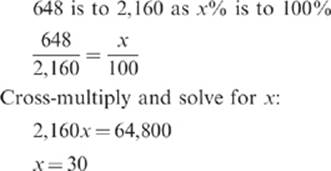
Cross-multiply and solve for x:

30% of the residents have a white house. Therefore, 100%–30%, or 70% of the residents DO NOT have a white house.
5. The correct answer is D. To solve this problem, substitute –1 for q and 3 for s wherever those variables appear in the expression:

6. The correct answer is F. You can factor 6 out of (6p + 60) so that it is equal to 6(p + 10). Dividing 6(p + 10) by 6 results in p + 10.
7. The correct answer is B. Line s is a transversal that cuts the parallel lines, p and q. When a transversal cuts 2 parallel lines, all corresponding angles created have the same measurement. ∠ m corresponds with ∠ n, because they are alternate interior angles, they have the same measurement. Since you are given that m + n = 230°, both ∠ m and ∠ n must equal 230° ÷ 2, or 115°. There are 180° in a straight line. Therefore, if ∠ m is 115°, then ∠ omust be 180° – 115°, or 65°.
8. The correct answer is J. You are given the equation for the volume of a cylinder, and you are given the lengths of the 2 variables. Simply plug these values into the equation and solve:
Volume = πr2h
Volume = π(4)2(5)
Volume = π(16)(5)
Volume = π80, or 80π.
9. The correct answer is C. The absolute value of a number is the numerical value of a real number without regard to its sign. In order to solve this problem, you must first substitute the number 7 for the x in |4 – x|, so that you get |4 – 7|. Then, perform the operation within the vertical lines, so that you get |–3|. Since you must disregard the negative sign in order to determine absolute value, you know that the absolute value of |–3| is 3.
10. The correct answer is K. The first step in solving this problem is to recognize that the angles adjacent to the 110° and 135° angles are complementary to 110° and 135°. This means that, when added together, 110° and the angle adjacent to it must equal 180°, and 135° and the angle adjacent to it must equal 180°. So, the angle adjacent to 110° must equal 70°, and the angle adjacent to 135° must equal 45°. Fill in the measurements on the diagram as shown:
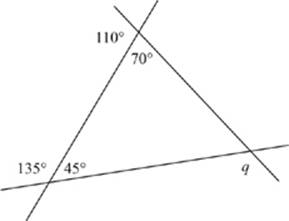
The sum of the interior angles of any triangle is 180°. So, 70° + 45°+ the measure of the third angle x = 180°. Solve for the measure of the third angle:
70 + 45 + x = 180
115 + x 180
x = 65
The angle adjacent to angle q is 65°, which means that angle q must be 180° – 65°, or 115°.
11. The correct answer is D. Use the FOIL method to solve this equation. Multiply the First terms, then the Outside terms, then the Inside terms, then the Last terms, as follows:
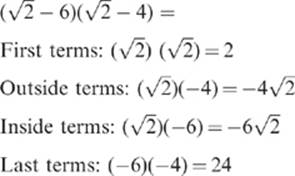
Now, add like terms together:
![]()
12. The correct answer is G. Use the FOIL method to solve this equation. Multiply the First terms, then the Outside terms, then the Inside terms, then the Last terms, as follows:
(x – 3y)2 = (x – 3y)(x – 3y)
First terms: (x)(x) = x2
Outside terms: (x)(–3y) = –3xy
Inside terms: (–3y)(x) = –3xy
Last terms: (–3y)(–3y) = 9y2
Now, add like terms together:
x2 + (–3xy) + (–3xy) + 9y2
x2 – 6xy + 9y2
13. The correct answer is A. Because you are looking for an odd integer, a good way to solve this problem is to pick a value for x, and try the answer choices to see which one yields an odd integer. You are given that x is an odd integer greater than 5, pick 7 as your substitute:
Answer choice A: x + 2 = 7 + 2 = 9; x + 2 yields an odd integer, so answer choice A could be correct.
Answer choice B: x + 3 = 7 + 3 = 10; eliminate answer choice B.
Answer choice C: x + 5 = 7 + 5 = 12; eliminate answer choice C.
Answer choice D: 3x 3 = (7) 21; while this is an odd integer, 21 is greater than 9, so answer choice D is not correct (remember, you’re looking for the next greater odd integer).
Answer choice E: x2 = 72 = 49; again, while this is an odd integer, it is greater than 9, which means that answer choice A must be correct.
If you remembered that the sum of an even and an odd number is always odd, you could have quickly recognized that answer choice A is correct.
14. The correct answer is J. In order to solve this problem, you must put the equations into the standard form, y = mx + b. The equation in the problem is equivalent to ![]() Convert the answer choices into the standard form:
Convert the answer choices into the standard form:
F. 3x + 11y = 6; 11y = –3x + 6; ![]()
G. 2x + 10y = 5; 10y = 2x + 5; ![]()
H. 3x + y = 8; y = –3x + 8
J. 3x + 24y = 9; 24y = –3x + 9; ![]()
![]()
Answer choice J, when simplified, is the same equation as the one given in the problem, so this choice is correct.
15. The correct answer is B. To solve this problem, set up an equation. The combined age is 24, which means that Anne’s age plus Kyle’s age equals 24. Solve for Anne’s age:
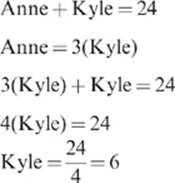
Anne is 6 × 3, or 18 years old.
16. The correct answer is H. Lines ![]() and
and ![]() are 2 parallel lines cut by transversals. This means that the angles created have special relationships. For example, opposite interior angles are congruent, that is, they have the same measurement. So, angle P is congruent to angle T, which means that the measure of angle T must also be 65°, answer choice H.
are 2 parallel lines cut by transversals. This means that the angles created have special relationships. For example, opposite interior angles are congruent, that is, they have the same measurement. So, angle P is congruent to angle T, which means that the measure of angle T must also be 65°, answer choice H.
17. The correct answer is D. If Carrie has seven dollars less than her brother, who has d dollars, then Carrie has d – 7 dollars. If she does not spend any money and earns three dollars, Carrie then has d – 7 + 3 dollars, or d – 4 dollars.
18. The correct answer is G. Solve for a by isolating a on the left side of the equation. Be careful to line up the decimal points:
0.2a + 1.8 = a – 2.2
0.2a–a –2.2 – 1.8
a is equivalent to 1.0 a; 1.0 – 0.2 = .8

19. The correct answer is A. The best way to solve this problem is to substitute the answer choices for x and solve until you get a negative number. Since the question asks you for the smallest integer, start with the smallest answer choice:
![]()
The smallest integer, x, that will result in a negative value is 2, answer choice A. Test this by trying the remaining choices.
20. The correct answer is K. To solve this problem, you could recognize that, if the ratio of the pieces is 2:3, then the larger piece will be equal to ![]() of the total length. This is true because the part to part ratio is 2:3, so the part to whole ratios must be equal to 2:5 and 3:5. Solve for
of the total length. This is true because the part to part ratio is 2:3, so the part to whole ratios must be equal to 2:5 and 3:5. Solve for ![]() of 30:
of 30:
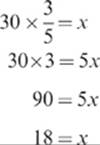
21. The correct answer is B. The formula for the area of a circle is πr2. Since the area is given as 49π, r2 must equal 49, and r must equal 7. The diameter is equal to twice the radius, so the diameter equals 2(7), or 14.
22. The correct answer is H. The first step in solving this problem is to recognize that the figure is made up of a right triangle and a rectangle. Calculate the area of each separate figure, then add the results to get the area of the entire figure:
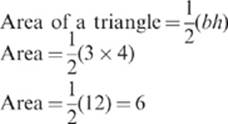
The area of the triangle is 6.
Area of a rectangle = l×w
Area = 7 × 4 =28
The area of the rectangle is 28. Therefore, the area of the figure shown is 6 + 28, or 34.
23. The correct answer is D. The question asks you to reduce the equation into simpler terms. Since there are 3 variables, a, b, and c, begin simplifying the as first, then the bs, and finally the cs. When multiplying like coefficients with exponents, add the exponents. When dividing like coefficients with exponents, subtract the exponents. Consider the following:
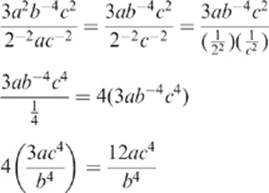
24. The correct answer is J. To solve this problem, cross-multiply and solve for x, as follows:
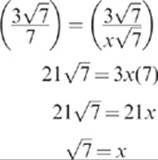
25. The correct answer is D. The first step in solving this problem is to rearrange the terms and set the equation equal to 0:
3x2 – 4x = 0
The next step is to factor the common value, x, from each of the terms:
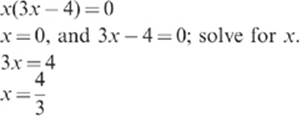
Therefore, the solutions for x are 0 or ![]() .
.
26. The correct answer is K. The slope of a line measures the steepness of a line, and can be calculated by using the following formula: ![]() Two points on the line are given: (3, –8) and (4,7). The y values are –8 and 7, so the change in y is –8 – 7, or –15. The x values are 3 and 4, so the change in x is 3 – 4, or – 1. The slope is – 15 over – 1, or 15.
Two points on the line are given: (3, –8) and (4,7). The y values are –8 and 7, so the change in y is –8 – 7, or –15. The x values are 3 and 4, so the change in x is 3 – 4, or – 1. The slope is – 15 over – 1, or 15.
27. The correct answer is B. A circle centered at (a,b) with a radius r has the equation (x – a)2 + (y – b)2 = r2. Plug the information given in the question into the equation:
(x–2)2 + (y–(–7))2 = 52
(x–2)2 + (y + 7)2 = 25
28. The correct answer is H. The key to solving this problem is to recognize that 8x2 – 8x – 6 can be factored, as follows:
8x2 – 8x – 6
= (2x – 3)(4x + 2)
So, (2x – 3)(4x + 2) = (ax – 3)(4x + a). Therefore, a must equal 2.
29. The correct answer is A. The slope-intercept form of a line is y = mx + b, where m is the slope and b is the y-intercept. By definition, a line perpendicular to any given line will have a slope equal to the negative reciprocal of the given line. Since the slope of the given line is ![]() a line perpendicular to the given line will have a slope of 4. Eliminate answer choices B, D, and E, because they do not have a slope of 4. You are given that another point on the line is (0, –5). This means, that when x = 0, y = –5; by definition, therefore, –5 is the y-intercept. So the slope-intercept form of the line in the question is y = 4x – 5.
a line perpendicular to the given line will have a slope of 4. Eliminate answer choices B, D, and E, because they do not have a slope of 4. You are given that another point on the line is (0, –5). This means, that when x = 0, y = –5; by definition, therefore, –5 is the y-intercept. So the slope-intercept form of the line in the question is y = 4x – 5.
30. The correct answer is K. To solve this problem, set up a proportion showing the relationship between the quantity of flour and the number of cookies.
24 cookies is to 60 cookies as 2 cups of flour is to x cups of flour.
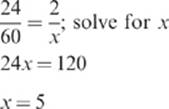
31. The correct answer is D. One way to solve this problem is to substitute in the answer choices for the first p-value and solve the equation. Start with the answer choice in the middle, answer choice C. Since you are multiplying by a decimal, if substituting answer choice C into the equation yields a result that is too small, you can eliminate any answer choices that are greater than answer choice C:
0.1(800 + 1,800) =
0.1(2,600) = 260; 260 is smaller than 800.
Now you can eliminate answer choices A, B, and C. Try answer choice D:
0.1(200 + 1,800) = 200; 200 = 200, so answer choice D is correct.
32. The correct answer is F. The formula of a circle is (x – a)2 + (y – b)2 = r2, where (a,b) is the center of the circle, and r is the radius. The diagram shows one edge of the circle at (6,0), and the other at (0,0). The midpoint between 0 and 6 is 3, so the radius is 3 and the center of the circle is at point (3,0). Plug these values into the formula for a and b and the radius, 3, for r:
(x – 3)2 + (y–0)2 = 32
(x – 3)2 + y2 = 9
33. The correct answer is B. To find the solution for the given inequality, isolate x on the left side of the inequality:
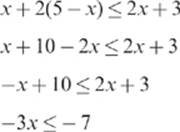
Now, you need to divide both sides of the inequality by –3; remember to reverse the inequality sign:
![]()
34. The correct answer is K. Remember that when you raise an exponent to another exponent, you must multiply the exponents. Therefore, the correct answer will include a16. Only answer choice K includes the correct exponent value, so it must be correct. The complete mathematical solution is shown next:
(4a4)4 = 44a4×4 = 256a16
35. The correct answer is B. The formula for the area of a parallelogram is base × height. You will need to calculate the height by applying the Pythagorean Theorem: a2 + b2 = c2. The unshaded region is a right triangle, so plug the given values into the Pythagorean Theorem:
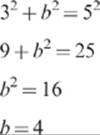
The height of the parallelogram is 4. The base is given as 8, so the area of the parallelogram is 4 × 8, or 32. Now, calculate the area of the unshaded triangle and subtract it from the total area of the parallelogram. The area of a triangle is ![]() (bh), where b is the base, and h is the height:
(bh), where b is the base, and h is the height:
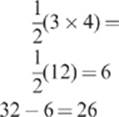
36. The correct answer is K. This problem requires you to solve for x. Isolate x on the left side of the equation:

Now, find the lowest common denominator so that you can add and subtract the fractions. Since both 4 and 8 go into 8, 8 is the lowest common denominator:
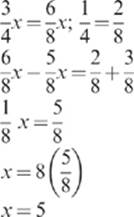
37. The correct answer is D. By definition, a right isosceles triangle has 2 sides of equal length and the hypotenuse is equal to ![]() times the length of either of the sides. Therefore, the smaller isosceles triangle with a hypotenuse of
times the length of either of the sides. Therefore, the smaller isosceles triangle with a hypotenuse of ![]() cm has 2 sides with lengths both equal to 2 cm. To answer this question, you must recognize that similar triangles have the same shape and the same proportions. You are given that the larger, similar triangle has a perimeter 2 times the perimeter of the smaller triangle. Therefore, each side in the larger triangle must be 2 times the length of the corresponding side in the smaller triangle. Since the 2 equal sides of the smaller triangle are each 2 cm, the 2 equal sides of the larger triangle are each 4 cm.
cm has 2 sides with lengths both equal to 2 cm. To answer this question, you must recognize that similar triangles have the same shape and the same proportions. You are given that the larger, similar triangle has a perimeter 2 times the perimeter of the smaller triangle. Therefore, each side in the larger triangle must be 2 times the length of the corresponding side in the smaller triangle. Since the 2 equal sides of the smaller triangle are each 2 cm, the 2 equal sides of the larger triangle are each 4 cm.
38. The correct answer is G. To solve this problem, you should calculate the area of the parallelogram and the area of the triangle, then add the results. The area of a parallelogram is equivalent to the base times the height. The area of a triangle is equivalent to ![]() (bh), where b is the base and h is the height. You will need to use the Pythagorean Theorem to calculate the height, which will be the same for both the parallelogram and the triangle.
(bh), where b is the base and h is the height. You will need to use the Pythagorean Theorem to calculate the height, which will be the same for both the parallelogram and the triangle.
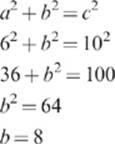
Now, plug the appropriate values into the equations:

39. The correct answer is A. By definition, the sine of any acute angle is calculated by dividing the length of the side opposite the acute angle by the hypotenuse ![]() The length of the side opposite angle a is 3, and the length of the hypotenuse is 5. Therefore,
The length of the side opposite angle a is 3, and the length of the hypotenuse is 5. Therefore, ![]()
40. The correct answer is H. The first step in solving this problem is to solve each element of the equation for x.
(x + m) = 0
x = –m
(x + n) = 0
x = –n
Now, substitute the value of the solutions given in the equation for x in order to get the values for m and n:
x = –m; –3 = –m, so m = 3
x = n; 5 n, so n = –5
Now add m (3) to n (–5):
3 + –5 = –2
41. The correct answer is D. The slope-intercept form of the equation for a line is y = mx + b, where m is the slope and b is the y-intercept. You can determine the slope of the line with the 2 points given in the question: (–2,–1) and (2,2). By definition, the slope is equal to ![]()
![]()
The slope of the line is ![]() . Use this value as m and 1 of the 2 points given in the question as x and y in the equation for a line. Solve for b:
. Use this value as m and 1 of the 2 points given in the question as x and y in the equation for a line. Solve for b:
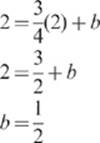
The equation of this line is ![]() The question asks you to determine what the value of x is when y = 5, so substitute 5 for y in the equation of the line and solve for x:
The question asks you to determine what the value of x is when y = 5, so substitute 5 for y in the equation of the line and solve for x:

When y = 5, x = 6.
42. The correct answer is F. By definition, the tangent of any acute angle is ![]() Sin B is given as
Sin B is given as ![]() and cos B is given as
and cos B is given as ![]() Therefore, tan
Therefore, tan ![]() To divide fractions, multiply the numerator by the reciprocal of the denominator:
To divide fractions, multiply the numerator by the reciprocal of the denominator: ![]() the 17s will cancel each other out, so tangent
the 17s will cancel each other out, so tangent ![]()
43. The correct answer is A. The first step in solving this problem is to recognize that you are looking for the equation of a line in the slope-intercept form, y = mx + b, where m is the slope and b is the y-intercept. Since the line shown intersects the y-axis at 5, the y-intercept must be 5. Eliminate answer choices C, D, and E. Since the line shown has a positive slope, answer choice A must be correct. You can calculate the slope as the change in y-values over the change in x-values:
![]()
44. The correct answer is H. Two adjacent angles have one common ray. As in the picture below, the noncommon rays form a straight angle (a line) which has a measure of 180°.

Given that the measure of one angle is twice (2x) that of the other angle (x), the total degree measure of the angles can be found by setting 180° equal to 3x (180 = 3x). Solve for x (the measure of the smaller angle) to get 60°.
45. The correct answer is D. One way to solve this problem is to recognize that each of the 6 letters can be involved in 20 different 3-letter combinations. For example, when P is in the first position, and O is in the second position, there are 4 possible 3-letter combinations (PON, POI, POE, and POS). Likewise, when P is in the first position, and N is in the second position, there are an additional 4 possible 3-letter combinations (PNO, PNI, PNE, and PNS). Therefore, because you cannot repeat a letter, each letter can be included in 5 × 4 = 20 different combinations; a total of 120 (6 × 20) 3-letter orderings can be made.
46. The correct answer is H. The volume of a cube is calculated by multiplying the length by the width by the height (l)(w)(h). You are given that each side has a length of 5 centimeters, so the volume would be equivalent to 5 · 5 · 5, or 53.
47. The correct answer is E. This problem requires you to find the values of x that make 3x2 + 4x – 15 positive. Set up the inequality 3x2 + 4x – 15 > 0. One approach is to solve this as if there was an equal sign:
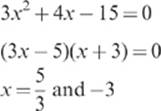
These numbers tell you when 3x2 + 4x – 15 is equal to 0. Since answer choices A, B, C, and D do not reference both of these numbers, they can be eliminated. To make sure that answer choice E is correct, pick a number that is greater than ![]() , like 2. Plug 2 into the expressions and see if it yields a positive result. Pick another number that is less than –3, like –4. Plug –4 into the expression and see if it yields a positive result. Since both do, answer choice E is correct.
, like 2. Plug 2 into the expressions and see if it yields a positive result. Pick another number that is less than –3, like –4. Plug –4 into the expression and see if it yields a positive result. Since both do, answer choice E is correct.
48. The correct answer is F. By definition, in a perfect square trinomial the first and last terms are perfect squares, and the middle term is twice the product of the square roots of the first and last terms. Eliminate answer choices G and J because the last terms are not perfect squares. Eliminate choice H because the first term is not a perfect square. Look at the middle term in answer choices F and K; 12 = 2(2 · 3), so answer choice F is a perfect square trinomial:
4x2 + 12x + 9 = (2x + 3)(2x + 3)
49. The correct answer is E. By definition, a rational number can be expressed as a ratio of 2 integers. Whole numbers are rational numbers, as are fractions and most decimal numbers. Since you are given that both p and q are negative integers, all of the operations represented by the roman numerals will result in rational numbers. Negative numbers can be rational; pick numbers that solve the equation given, to check this theory:
![]()
Now try the given operations using these values:
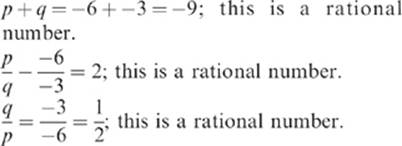
50. The correct answer is J. To solve this problem, make x minutes the time that it took Marcia to get to Alan’s house. On the way home, Marcia went 2 times as fast as she did going to Alan’s house, which means that it took her ![]() the time,
the time, ![]() or
or ![]() minutes. The total number of minutes that Marcia biked is equal to x minutes
minutes. The total number of minutes that Marcia biked is equal to x minutes ![]() minutes:
minutes:
![]()
To add the fractions together, you must convert x into like terms:
![]()
51. The correct answer is E. For this problem, the best approach is to use the given equation and test the answer choices to see which yields the greatest value. Replace r with each of the values in the answer choices and solve the equations:

Answer choice E yields the greatest, or maximum value.
52. The correct answer is K. The sum of the interior angles of a regular octagon is 6(180°), or 1,080°. Since all of the angles are the same, each interior angle is ![]()
53. The correct answer is D. The best way to solve this problem is to set up a table indicating the time period in years, and the number of both CDs and videogames purchased during the years given. The consumption rate is the same, so, based on information in the problem, you can fill in the table as follows:
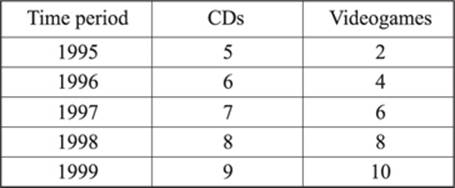
Teenagers bought the same average number of CDs and videogames in 1998.
54. The correct answer is G. To solve this problem, extend the transversals so that they cross the parallel lines again, as shown below:
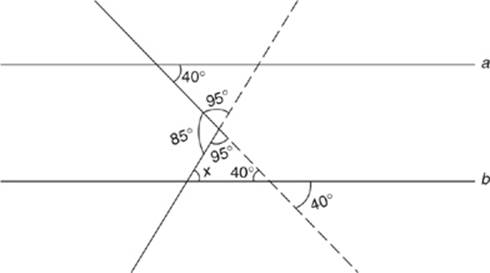
Apply the rules regarding parallel lines cut by a transversal to fill in the angle measures. Because the total measure of the other 2 angles of the triangle created by extending the transversals is 135, the measure of angle x must be 45.
55. The correct answer is E. This question tests your ability to recognize and apply the distributive property. According to the distributive property, for any numbers a, b, and c, c(a + b) = ca + cb. According to the distributive property, a(b + c) =
ab + ac is equivalent to ca + ba, so roman numeral I is correct; eliminate answer choices B and C.
ab + ac, so roman numeral II is correct; eliminate answer choice A.
(b + c)a, so roman numeral III is also correct, eliminate answer choice D.
Since all of the operations are equivalent to a(b + c), answer choice E is correct.
56. The correct answer is F. By definition, the tangent of any angle is ![]() Therefore,
Therefore, ![]() simplified as (tan x) ·
simplified as (tan x) · ![]() is equal to
is equal to ![]() Multiply the fractions, first canceling the sin x from the numerator and denominator to get:
Multiply the fractions, first canceling the sin x from the numerator and denominator to get:
![]()
57. The correct answer is C. The absolute value is always positive, so in order for the absolute value of x3 to equal –x3, x must be either a negative number or 0, answer choice C. If you cube a negative number, the result is always negative. So, if x were equal to –1, for example, the absolute value of x3 would be (–1)(–1)(–1), or 1. The value of –x3 would also be 1, because –(–1)3 is equivalent to 13. Zero is an option as well, since 0 is neither negative nor positive, and 0 raised to any power is still 0.
58. The correct answer is F. The best way to solve this problem is to substitute in the answer choices for c and factor the equation:
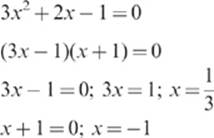
Answer choice F gives you 2 real solutions for x. Testing the other answer choices will yield 2 distinct complex roots, not real roots.
59. The correct answer is B. You are given that angle QPR and angle PRS are right angles; you are also given the lengths of diagonal PR (12), and side PS (20). Draw a diagram to help visualize the problem:
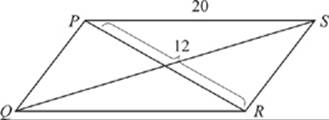
You should now see that you have the length of 1 side of the right triangle PRS (12), and the length of the hypotenuse (20). Use the Pythagorean Theorem to calculate the length of the remaining side:
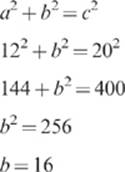
The length of RS is 16.
60. The correct answer is K. Before you answer the question, notice that the ramp forms a triangle with sides s and x, and a hypotenuse of an unknown length that represents the length of the ramp. The slope of the ramp can be defined in the same way the slope of a line is defined: ![]() In this instance, the change in y is the vertical length, or height of the triangle, and the change in x is the horizontal length, or base of the triangle. If the slope of the ramp is t, then:
In this instance, the change in y is the vertical length, or height of the triangle, and the change in x is the horizontal length, or base of the triangle. If the slope of the ramp is t, then:

Now that you have a value for x, you can use the Pythagorean Theorem: a2 + b2 = c2. Solve for the length of the ramp (or the hypotenuse), c:
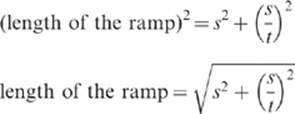
Reading Test Explanations
PASSAGE I
1. The best answer is B. Paragraph 2 states that the narrator “had fancied it was down nearer the Circus,” which suggests that he is not sure where the Magic Shop is, and had only “imagined” its location. The other answer choices are not supported by the context of the passage.
2. The best answer is G. In the first paragraph, the narrator states that, “I had not even been sure that the place was there, to tell the truth,” and later in the second paragraph that, “I had fancied it was down nearer the Circus, or round the corner in Oxford Street, or even in Holborn; always over the way and a little inaccessible it had been, with something of the mirage in its position.” Both of these statements support the idea that the shop’s location was not where the narrator expected it to be. This is best represented by answer choice G. Answer choice F is most nearly the opposite, and answer choices H and J describe the shop itself, not its location.
3. The best answer is A. The first paragraph indicates that the narrator “had seen the Magic Shop from afar several times; I had passed it once or twice;” this suggests that he first learned of the Magic Shop when he had passed by it before, answer choice A. The other answer choices are not supported by details in the passage.
4. The best answer is J. The context in which that statement was made suggests that Gip was a polite child, answer choice J. The passage indicates that Gip “inherits his mother’s breeding,” but not that he was worried about his mother, so eliminate answer choice F. The other answer choices are not supported by the passage.
5. The best answer is A. Paragraph 4 indicates that the narrator found the clerk’s action “unexpected,” which means the same as “surprising.” This best supports answer choice A.
6. The best answer is F. Based on the last two paragraphs, Gip’s reaction to the shopman’s trick can best be described as quietly astonished. Gip does not speak either during or after the trick, and after taking the glass balls he “resumed [the narrator’s] reassuring finger, and nerved himself for the next event.” The other answer choices are not supported by the passage.
7. The best answer is C. In the third paragraph, the narrator is taking his son into the magic shop to buy him some tricks for his birthday. Throughout the rest of the passage, it becomes clear that they are enjoying themselves, and that the narrator wants to have fun. “Anything amusing?” is how the narrator requests the type of tricks that they are looking for. The passage as a whole supports the idea that the relationship between narrator and son is one of enjoyment, answer choice C. Although the narrator does show patience in the magic shop, that is not the primary focus of his relationship with his son, so answer choice D is not best. Likewise, the other answer choices are not supported by the passage.
8. The best answer is J. The passage indicates that Gip is excited about entering the Magic Shop. He “hauled [the narrator] by my finger right up to the window” and went on to describe each of the items in the window. The other answer choices are not supported by the passage.
9. The best answer is A. Paragraph 4 suggests that the narrator and his son were surprised to find the shopman suddenly behind the counter; “and so with a start we were aware of him.” It is likely that this surprise caused them to stop laughing together, since this is what they were doing just before the surprise. The other answer choices are not supported by the passage.
10. The best answer is J. The last sentence in the passage states that Gip “nerved himself for the next event.” This suggests that, although he may have been a bit uncertain, he was ready to see the next trick, answer choice J.
PASSAGE II
11. The best answer is D. The passage focuses on the difficulties that Alaska and her inhabitants encountered on the way to achieving statehood. In fact, according to the passage, it “took almost 100 years from beginning to end.” This best supports answer choice D.
12. The best answer is G. The word enigma refers to a riddle, or anything that is puzzling. Since, according to Paragraph 1, the author doesn’t know a lot about Alaska (at least as compared to Hawaii) it makes sense that enigmawould mean “mystery,” answer choice G.
13. The best answer is A. Paragraph 1 states that the author was “a ten-year-old girl” when Alaska became a state. The paragraph goes on to state that “nearly fifty years later,… Alaska remains an enigma.” It is safe to conclude, then, that the author must be almost sixty years old, answer choice A.
14. The best answer is H. According to the passage, Alaska was a remote, unpopulated area that held little interest for most Americans. “Many people marveled at the stupidity” of Seward’s plan to purchase Alaska in 1867. However, when gold was discovered, people began to realize that Alaska had some value.
15. The best answer is B. The passage emphasizes Alaska’s struggle for statehood. You can infer that the reason the author posed the question is to introduce the main topic of the passage and follow it up with supporting information.
16. The best answer is H. While the author does offer some personal information, she does not make an emotional appeal, nor does she describe her childhood. Eliminate answer choice F. It is made clear in the passage that the author has never visited Alaska, so eliminate answer choice G. The bulk of the passage contains historical background information on Alaska’s progression to statehood, which best supports answer choice H.
17. The best answer is C. The statement that “Alaska’s own natural wealth was being stripped for the benefit of a handful of outside entrepreneurs” suggests that Alaskans were not reaping the benefits of their own land’s resources, answer choice C.
18. The best answer is F. Paragraph 4 states that “the bombing of Pearl Harbor … propelled Congress to provide Alaska with billions of dollars for defense spending,” which suggests that Congress was motivated to give Alaska money due to the onset of World War II.
19. The best answer is D. The only reason that the author contrasts Alaska and Hawaii throughout the passage is to emphasize her personal impressions of each state, answer choice D. The other answer choices are not supported by the passage.
20. The best answer is F. The final sentence in Paragraph 4 states that “Alaska finally gained its statehood on January 3, 1959, due primarily to growing and organized public and political pressure.” This best supports answer choice F.
PASSAGE III
21. The best answer is D. The passage states that “Ernest Hemingway is one of those rare authors most people know about, whether they have read him or not, because of his sensational publicity and personal invective. He has the distinction of being one of the most famous twentieth-century American writers with his image of ruggedness, confidence, virility, and bravery. He has been regarded less as a writer dedicated to his craft than as a man of action who happened to be afflicted with genius.” These details best support answer choice D.
22. The best answer is J. According to the passage, “He acquired his expertise through well-reported acts of participation as well as observation: by going to all of the wars of his time, hunting and fishing for great beasts. ...” These details contradict answer choice J, which makes it the best option.
23. The best answer is D. Details in the passage show that Hemingway was an outdoorsman who “rejected out of hand the role of the indoor esthete.” Additionally, the passage states that “Hemingway assuredly took some amusement in confounding public expectations of how a writer should look and conduct himself.”
24. The best answer is J. The passage states that, “Hemingway described the novel as less about the life of postwar expatriates than about the rhythms of nature as an expression of eternity.” Likewise, according to the author, “The novel pushes the limits of pastoral convention by testing its vision, acknowledging its enduring attraction, and questioning its very construct.” This information best supports answer choice J.
25. The best answer is C. Only “ecological values” and “traditional pastoral conventions” are mentioned in the passage as ways in which Hemingway’s novel has been interpreted.
26. The best answer is H. According to the passage, “The Sun Also Rises, has frequently been treated as a novel of the Lost Generation—a group of young American expatriate writers living in Paris who came of age during World War I and established their reputations in the 1920’s. They considered themselves “lost” because their inherited values could not operate in the postwar world, and they felt spiritually alienated from a country that they considered hopelessly provincial and emotionally barren.” This best matches answer choice H.
27. The best answer is C. Passage A presents Hemingway as an outdoorsman and naturalist who “pursued the hunting and fishing sports that he had learned from his father.” This is a reflection of the “meaning and value in cultivating a more intimate connection with the natural environment” desired by the characters in his novel.
28. The best answer is H. A main focus in both passages is Hemingway’s connection to nature and how that connection shaped his writing.
29. The best answer is C. According to Passage A, Hemingway “wrote about what he knew best: traveling, bullfights, libations, women, wars, big game hunting, deep-sea fishing, and courage. He acquired his expertise through well-reported acts of participation as well as observation: by going to all of the wars of his time, hunting and fishing for great beasts, marrying four times, occasionally getting into fistfights, and drinking to excess.” Details in Passage B show that Hemingway’s novel “criticizes conventional depictions of nature and calls for a literature that offers a more complex picture of the connection between humanity and the natural world. It invokes the central elements of pastoral convention: the presentation of city life as complex and of city people as corrupt, the presentation of rural life (and of nature) as somehow more “real” and more simple than life in the city, and the presentation of rural folk as more honest, direct, and virtuous than city dwellers.”
30. The best answer is G. Hemingway’s passion and genius are established to some extent in both passages. Therefore, it is logical to believe that both authors viewed Hemingway as a passionate writer.
PASSAGE IV
31. The best answer is B. Throughout the passage the author discusses several options for eradicating EAB disease. The author also indicates that some of these options have not been proven (insecticide treatment), while others can be costly (cutting down and destroying infested trees). This suggests that the author believes EAB disease can possibly be controlled or eradicated, but it may take a lot of time and money. Answer choice B is best supported by information in the passage.
32. The best answer is J. The passage states that, “Ash Borer infestations are particularly troublesome because they are difficult to identify until the ash tree is heavily infested.” Additional details throughout the passage indicate that Ash Borer infestation eradication is costly and time-consuming.
33. The best answer is C. The passage indicates that the task of controlling and eradicating the Ash Borer will be very difficult and expensive. Because infestations are generally well underway before they are identified, the scope of the task is considered exceptional.
34. The best answer is J. The primary focus of the first paragraph is the destruction of millions of trees and the infestation of “over 5,000 square miles of Michigan and Canadian land,” which suggests that the main worry expressed is the decimation (extensive destruction) of ash trees in North America, answer choice J.
35. The best answer is A. Clearly the author is interested in the study of EAB disease. In addition, the author expresses a concern for the spread of the disease, as well as for the quantity of time and money that most likely will be needed to study EAB disease. The other answer choices are not supported by details in the passage.
36. The best answer is J. According to the passage, Agrilus planipennis is the scientific name for the Emerald Ash Borer beetle, answer choice J.
37. The best answer is A. The passage states that infested trees are being “cut down and destroyed, along with the beetle colonies, or galleries.” The other answer choices are not supported by the passage.
38. The best answer is H. The passage clearly states that the EAB beetle is native to Asia, answer choice H.
39. The best answer is D. Paragraph 2 states that, “the adults settle high within the tree’s canopy.” The “canopy” refers to the upper branches of the ash tree, answer choice D.
40. The best answer is G. According to the passage, “identification of infested trees is taking place in all susceptible areas,” and that “identified trees are being cut down and destroyed.” While insecticide spray is being considered as a method of control, the passage does not indicate that it is currently being used. Eliminate answer choice H. The other answer choices are not supported by details in the passage.
SCIENCE TEST EXPLANATIONS
PASSAGE I
1. The correct answer is C. To answer this question, look at the list of drawbacks for each drug-delivery system. According to Table 1, in the Pressure drug-delivery system, “food taken with the capsule may alter the pressure enough to disintegrate the capsule in the stomach.”
2. The correct answer is G. The passage states that “new research has targeted the colon as an ideal environment for drug absorption to treat certain illnesses.” This suggests that the intended target in these experiments is the colon. According to the results of Experiment 2 (found in Table 3) the tablet with the “A” outer coating and the “2” inner coating reached the colon in the shortest amount of time.
3. The correct answer is B. The results of Experiment 1 are shown in Table 2. Both Group I and Group II included tablets with Tracer A, but the tablets in each group had different coatings. Therefore, it is most likely that the coating, not the tracer would have a greater impact on either gastric emptying time or colonic arrival; eliminate answer choices A and D. Since the target is the same for all groups (the colon) the drug’s target destination will not be affected; eliminate answer choice C. You can see that with Coating 2, the colonic arrival time is faster than with Coating 1, which best supports answer choice B.
4. The correct answer is J. According to the results of both experiments, across all groups, the time that remained standard, or constant, was the gastric emptying time, answer choice J.
5. The correct answer is D. Table 1 provides details about each drug-delivery system. When you locate Time-dependent delivery, you see that the mechanics of the delivery include an inner barrier that delays release, answer choice D. The other answer choices are not associated with time-dependent delivery.
PASSAGE II
6. The correct answer is J. To answer this question you need to consider the data in both Table 1 and Table 2. According to Table 2, the source rock basalt results in either schist or amphibolite. Table 1 indicates that schist is a foliated rock, and amphibolite is a nonfoliated rock. Therefore, the metamorphic results of basalt can be either foliated or nonfoliated.
7. The correct answer is C. Look at Table 2 and find marble in the second column. The source rock is listed directly to the left, in the first column. Based on Table 2, limestone is the source rock for marble.
8. The correct answer is F. Figure 1 indicates that at low levels of metamorphic intensity there is little to no foliation. As metamorphic intensity increases, so does foliation. This best supports answer choice F.
9. The correct answer is B. According to Figure 1, shale is at the far left of the metamorphic intensity scale. This corresponds to a low level of intensity. Schist forms at a higher level of metamorphic intensity, as shown in Figure 1. This data best supports answer choice B.
10. The correct answer is F. According to Table 2, rhyolite is the source rock for schist. This means that, at a certain level of intensity, rhyolite becomes schist. Schist is the source rock for gneiss. It would be logical to conclude that levels of metamorphic intensity increase as one type of rock changes into another, as Figure 1 indicates. Figure 1 also shows that, as metamorphic activity increases, foliation increases. This information best supports answer choice F.
11. The correct answer is C. To answer this question, first find schist in Column 2 (Result) of Table 2. It appears 3 times, and is the result of 3 different source rocks: slate, rhyolite, and basalt, answer choice C.
PASSAGE III
12. The correct answer is H. The results of Experiment 1 are shown in Table 1. According to these results, the fastest dissolution time was recorded when the tablet was in fine-powder form, dissolved in ethanol, answer choice H.
13. The correct answer is A. According to the passage, the tablets were only dissolved in water in Experiment 2, whereas both water and ethanol were used as solvents in Experiment 1. This best supports answer choice A.
14. The correct answer is J. Based on Table 1, the dissolution time was always faster when the tablet was crushed, answer choice J. The other answer choices are not supported by the passage.
15. The correct answer is B. The temperature was varied in Experiment 2, so look at Table 2 first to answer this question. At 80°, it took 12 seconds for a whole tablet to dissolve. According to Experiment 1, crushing the tablet resulted in faster dissolution times. Therefore, you can conclude that the dissolution time would be faster than 12 seconds, answer choice B.
16. The correct answer is J. The results of Experiment 1 reveal that crushing the tablet increases the dissolution rate, as does dissolving the tablet in ethanol. Eliminate answer choices G and H. Table 2 indicates that lower temperatures result in slower dissolution times. This best supports answer choice J.
17. The correct answer is A. The results of Experiment 1 indicate that crushing the tablet increases the dissolution rate, so eliminate answer choices B and C. According to Table 2, lower temperatures result in slower dissolution times, so dissolving a whole tablet in 10°C water would be slower than dissolving a whole tablet in 80°C water.
PASSAGE IV
18. The correct answer is F. The passage states that the average starting length of the rats in each group was 10 cm. Beginning with answer choice F, calculate the difference between the starting length and the average length after 6 weeks for each group:
Group 6: 18.25 – 10.00 = 8.25 cm
Group 2: 18.00 – 10.00 = 8.00 cm
Group 7: 14.25 – 10.00 = 4.25 cm
Group 4: 17.00 – 10.00 = 7.00 cm
The rats in Group 6 increased the most in average length, answer choice F.
19. The correct answer is A. The passage states that the average starting weight of the rats in each group was 200 grams. Find the corresponding group on Table 2 for each feed-type listed, and calculate the difference between the starting weight and the average weight after 6 weeks for each group:
Feed M = Group 5: 352 – 200 = 152 g
Feed N = Group 6: 349 – 200 = 149 g
Feed O = Group 7: 342 – 200 = 142 g
Feed P = Group 8: 344 – 200 = 144 g
Feed M resulted in the greatest weight gain, answer choice A.
20. The correct answer is J. The passage states that the rats in each group weighed an average of 200 grams at the start of the experiments. Starting with answer choice F, calculate the difference between the starting weight and the average weight after 6 weeks for all groups:
Group 1: 350 – 200 = 150 g
Group 3: 343 – 200 = 143 g
Group 5: 352 – 200 = 152 g
Group 7: 342 – 200 = 142 g
The rats in Group 7 gained the least amount of weight, answer choice J.
21. The correct answer is C. According to the question, Group 9 would receive Feed M (the same as Group 5) and a vitamin supplement (like Group 6). According to Table 1 and the information in the passage, the rats in Group 6 had a greater average length than did Group 5 after 6 weeks. Therefore, if Group 9 is fed vitamin supplements, the rats will most likely have a greater average length than the rats in Group 5, answer choice C.
22. The correct answer is J. The best way to answer this question is to examine each of the answer choices, and eliminate those that are not supported by the data in Table 2. Group 7 is the control group. Group 6 was fed Feed N. It is not true that the rats in Group 6 were twice as long as the rats in Group 7, so eliminate answer choice F. Group 5 was fed Feed M. It is not true that the rats in Group 5 weighed 3 times more than the rats in Group 7, so eliminate answer choice G. Group 8 was fed Feed P; rats in this group did not have the greatest average length, so eliminate answer choice H. Answer choice J is correct, because it is true that the rats in Group 7 are similar in both weight and length to the rats in Group 8.
PASSAGE V
23. The correct answer is D. According to Table 2, granite is phaneritic in texture. Table 1 indicates that phaneritic rocks cool slowly, and Figure 1 indicates that phaneritic rocks have coarse grains. This information best supports answer choice D.
24. The correct answer is H. According to Table 2, both rhyolite and andesite are aphanitic in texture. Table 1 indicates that aphanitic rocks cool “quickly but more slowly than glassy textured rocks,” answer choice H.
25. The correct answer is A. Figure 1 indicates that phaneritic rocks have a slower cooling rate and coarser grain size than either glassy or aphanitic rocks. According to Table 1, the grains in phaneritic rocks can be seen without a microscope, so they are larger than the grains of both glassy and aphanitic rocks. This information best supports answer choice A.
26. The correct answer is G. To answer this question, look at the cooling characteristics listed in Table 1. Glassy rock “cools rapidly and above the temperature for crystals to form.” This information best supports answer choice G.
27. The correct answer is C. Table 1 indicates that aphanitic rocks cool quickly. Table 2 lists rhyolite, andesite, and basalt as aphanitic rocks. The other answer choices are not supported by information in the passage.
28. The correct answer is G. According to Table 1, rocks with interlocking grains that can be seen without a microscope are classified as phaneritic rocks. The cooling characteristics of phaneritic rocks indicate that the rocks “cool very slowly at a uniform rate,” answer choice G.
PASSAGE VI
29. The correct answer is B. The passage states that the sun has a mass of 1. Therefore, star type B, with a mass of 18, has a mass 18 times that of the sun.
30. The correct answer is J. To answer this question, find the column for surface temperature in Table 1. Stars with a surface temperature less than 3,500 K are red in color, answer choice J.
31. The correct answer is A. The giant stars shown in Figure 1 have a surface temperature ranging from about 5,000 K to about 2,500 K. According to Table 1, stars at these temperatures will range from orange to red, answer choice A.
32. The correct answer is H. This question requires you to look at both Figure 1 and Table 1. The main sequence stars in Figure 1 have a temperature range from about 20,000 K down to about 2,500 K. According to Table 1, star type O has a surface temperature that ranges from 28,000 K to 60,000 K. Star type O, therefore, is NOT a main sequence star.
33. The correct answer is B. To answer this question, look at Figure 1. A star with a temperature of 15,000 K and a luminosity of 10-4 would most likely be a white dwarf, answer choice B.
PASSAGE VII
34. The correct answer G. To answer this question look at both Table 1 and Table 2. The data presented in each table indicate that, at 40% relative humidity, Litter C absorbs water faster than either Litter A or Litter B.
35. The correct answer is D. According to Table 1, at 80% relative humidity, Litter B absorbs water in about 9 hours. It makes sense that at a higher relative humidity level, it would take longer to absorb water, so answer choice D is correct.
36. The correct answer is F. To answer this question, compare the answer choices with the data presented in Table 1. Based on Table 1, Litter A took 16 hours to absorb water at a relative humidity level of 80%, Litter B took 9 hours, and Litter C took 5 hours. This information best supports answer choice F.
37. The correct answer is C. In Experiment 1, the relative humidity levels were varied from 40% to 80%, while in Experiment 2, the relative humidity level was held constant at 40%. The other answer choices are not supported by the passage.
38. The correct answer is F. According to the results of both experiments, adding baking soda to the litter decreased the absorption time for Litter A only, answer choice F.
39. The correct answer is D. It makes sense that decreasing the quantity of water added to all of the litter types would also decrease the absorption time. The other answer choices are not supported by the passage.
40. The correct answer is H. The results of the experiments indicate that the different litter types had different absorption rates. This best supports answer choice H. The other answer choices are not supported by the results of the experiments.